This Page is http://www.mmdtkw.org/ALRItkwVes05VillaMysteries.html
Unit 05 Pompeii/Vesuvius
Unit 05 Pompeii/Vesuvius

Villa
of
the Mysteries

http://www.mmdtkw.org/ALRIVes0501Villa_Rustica-a.jpg
Ancient Roman villas were country homes, and they spanned a continuum from simple farm houses through huge complexes that may or may not have any agricultural purposes. The simplest form, illustrated above, has a house with two connected rooms and another separate room beside them. Inside the walls and behind the house is a small garden. There is a small partly shaded area (call it a patio?) in front of the house and in front of that a farmyard where animals could be corralled. Side rooms off the farmyard could shelter animals or slaves or could be used for storage of tools or products. The whole structure is walled for security -- enemies or bandits come to mind -- and fields, pastures, etc. would expand outward.

http://www.mmdtkw.org/ALRIVes0502HadrianVilla.jpg
The other end of the continuum is Hadrian's Villa (Villa Adriana) in Tiburtina, now Tivoli, about forty-five minutes east of Rome by car. It had pools, baths, two theaters, entertainment areas, and everything else an emperor might desire. Many features were modeled after things Hadrian saw in his extensive travels. He traveled so much, in fact that he seldom had the opportunity to enjoy his country home. Complexes of this size would always be under continuous construction and reconstruction, but architects and archeologist nonetheless say that it was "completed" shortly before Hadrian's death in 138 AD. There are no agricultural production areas (presses, carding rooms, etc.) although tools consistent with floriculture, arboriculture, and kitchen gardening were found. Imperial real estate would have included productive farms either adjacent of elsewhere, under management of subordinates -- probably imperial freedmen and slave overseers. This site has nothing to do, of course, with Pompeii/Vesuvius, etc., but it's included to show the range of possible villa establishments.
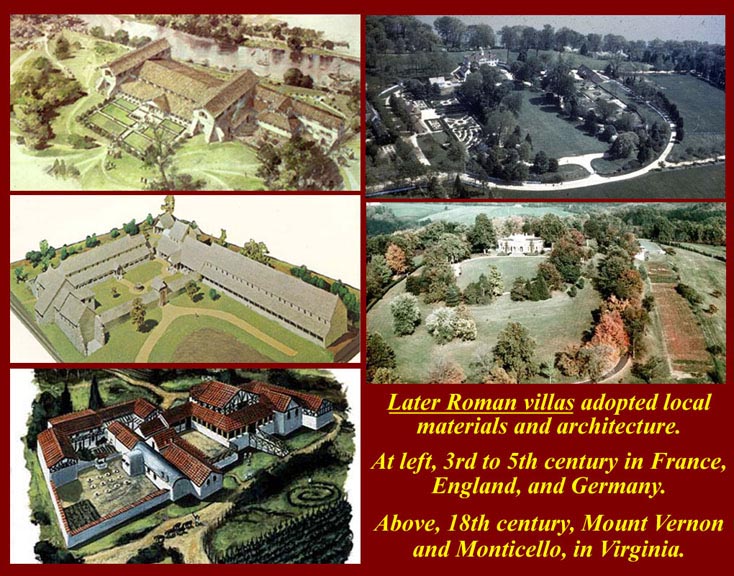
http://www.mmdtkw.org/ALRIVes0503LaterRomanVillas.jpg
Roman and Roman type villas spread throughout the empire and beyond and also down through the centuries. Prior civilizations also had their agricultural establishments and ex-urban estates, but the Romans seem to have, from our perspective, gotten it just right: we all yearn for that big country estate to which we could retire -- with, of course ample servants and currency to keep it fun. Our aspirations are not accidental. Our own "forefathers" (the word translates exactly with patricians) built country estates modeled after those big ancient Roman villas as they had been envisioned by Renaissance and English and French interpreters. "Provincial" villas almost always had agricultural as well as representational functions. And that includes, of course, those in Virginia. The Image shows artistic representations ancient villas in Britain, France, and Germany in the period of their Roman occupation and photographs of Mount Vernon and Monticello in Virginia.
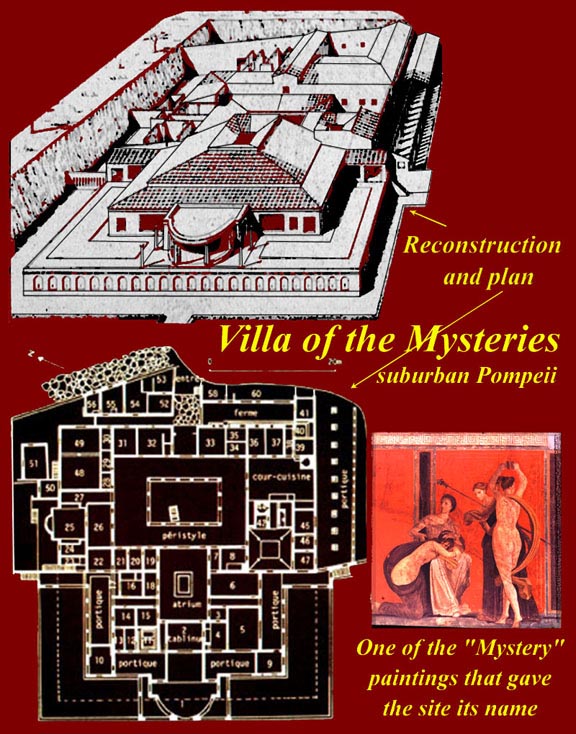
http://www.mmdtkw.org/ALRIVes0504VillaMyst.jpg
Our primary subject matter for this unit is the Villa of the Mysteries, which is located on the road that archeologists have dubbed the Street of the Tombs: it ran out of Pompeii through the Herculaneum Gate. There were two other suburban properties between the gate and the Villa of the Mysteries, which have been denominated by their excavators as the Villa of Cicero and the Villa of Diomedes. Being on the side of the city toward Vesuvius, they were buried deep in ash before taking the brunt of the pyroclastic surges/flows that crashed down the volcano's slopes. Although the Villa of the Mysteries was built on a high artificial platform on the slope of the volcano, it was completely covered by the debris: the current ground level is above the level of the top of the villa (including the 20th century roofs that were added to protect excavated wall art.) The Villa complex dates from the 2nd century BC but also includes important renovations and expansions from around 60 BC and again in the first half of the 1st century AD. It was seriously damaged during the earthquakes of the 60s AD and was still being repaired when it was overwhelmed by the eruption of 79 AD. The Villa is also known as the Villa Item (after the owners of the property on which it was excavated). Most of the excavation was done by Maiuri in the 20th century -- he was fascinated by the Dionysian mystery mural and turned it into his showpiece.
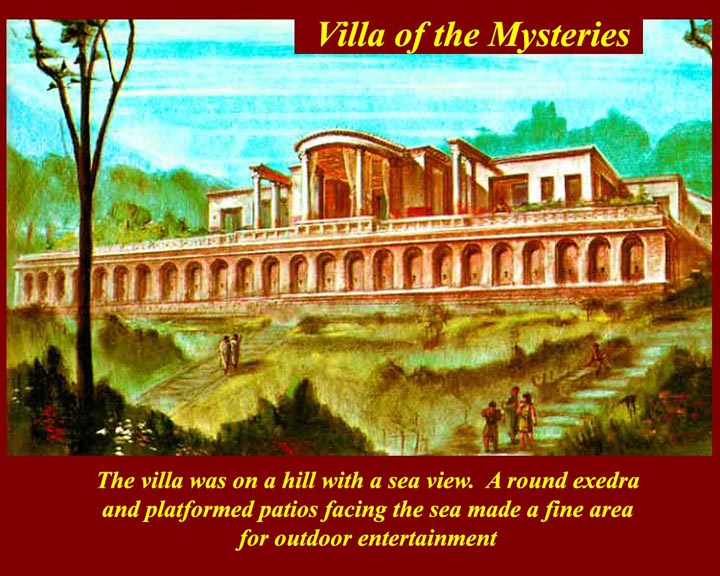
http://www.mmdtkw.org/ALRIVes0505VillaMysteriesElav.jpg
The Villa of the Mysteries as it would have looked before the 79 AD eruption. It was built on the southeastern slope of mount Vesuvius, a short distance outside the Herculaneum gate. To make a level site, an artificial platform was built, the spaces below ://www.mmdtkw.org/the platform being used for storage and later as cellars for the winery installed late in the structure's history. The side to the left of the picture and the side facing the viewer had good views of the sea. The side to the right of the picture contained servants'/slave quarters and work areas. The main entrance was on the side away from the viewer, and it was on both sides of that entrance that more rooms associated with agriculture and wine making were added.
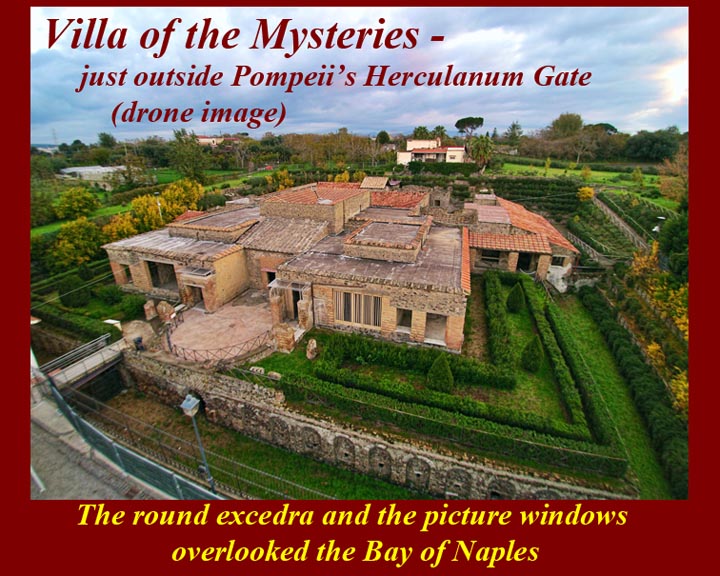
http://www.mmdtkw.org/ALRIVes0505xVillaMysteries-Drone.jpg
Drone image of the Villa of the Mysteries
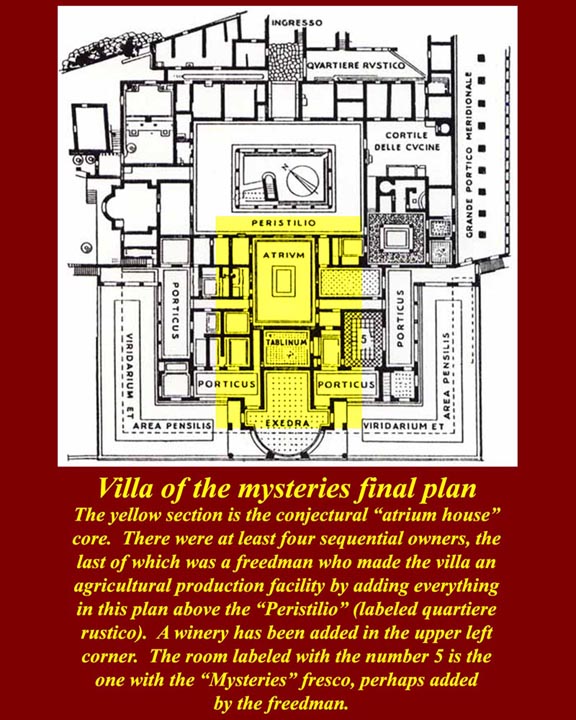
http://www.mmdtkw.org/ALRIVes0506VillaMysteriesPlan.jpg
The plan shows a conjectural core area that would have been an "atrium house". There were several periods of expansion and rebuilding, the last of which involved major repairs after the earthquakes of the early 60s AD. The areas labeled viridarium are gardens, and the areas pensilis are suspended or hanging, i.e., supported on arches. "Hanging gardens" are built over cryptoportici = subsurface arched passageways, and that's what we have here.
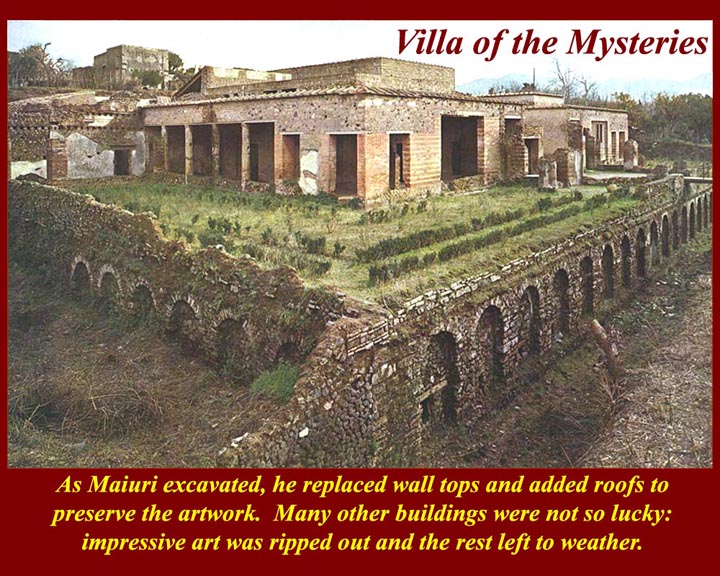
http://www.mmdtkw.org/ALRIVes0507NewRoofs.jpg
The arches of the cryptoportici are clearly seen in the sides of the platform. They were designed to support the load, not to admit light, so they there was no problem closing them off with masonry for security purposes. Small grated windows did allow some air circulation and light penetration. Maiuri rebuilt the walls and added roofs to protect the art on the inside walls.
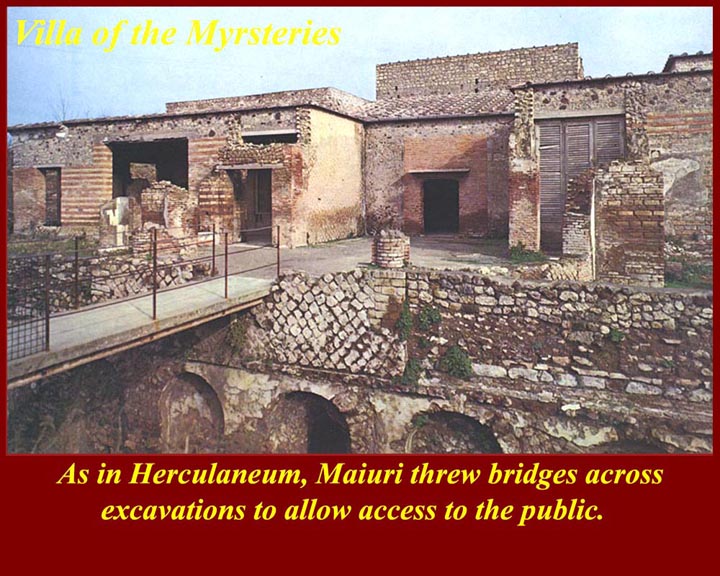
http://www.mmdtkw.org/ALRIVes0508VillaBridge.jpg
Access to the Villa site is over bridges from the surrounding un-excavated areas, this one into the area where the semi-circular exedra stood: the stumps of the two brick pillars that supported the exedra roof are visible as are several types of masonry work. All follow the same principle with stones of various shapes being inserted into the surface of cement. The part with the diagonally placed square stones is called opus reticulatum, which means "netted work" -- looks like a fishing net. The intermixture of different masonry work is the result of repeated reworking and repairs. Everything would have been sheathed either in smooth stonework or in stucco with the latter being most commonly used.
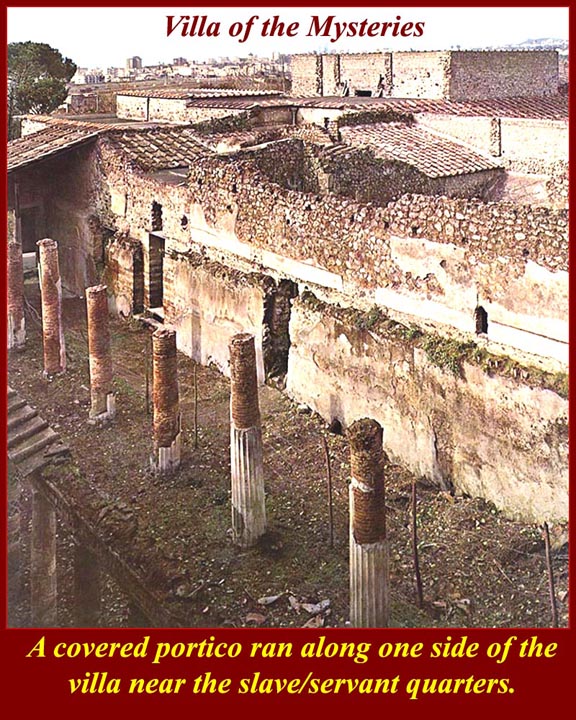
http://www.mmdtkw.org/ALRIVes0509SlaveServantPortico.jpg
On the side where the slave/servant quarters and work area was located there was a long covered portico to provide shade for outdoor work. The other side, with the winery, was unshaded -- standard practice was to keep the fermenting area warm to speed the process. Here we can see some of the stucco still on the outer wall of the house and some of the fluted stucco work on the brick pillars.
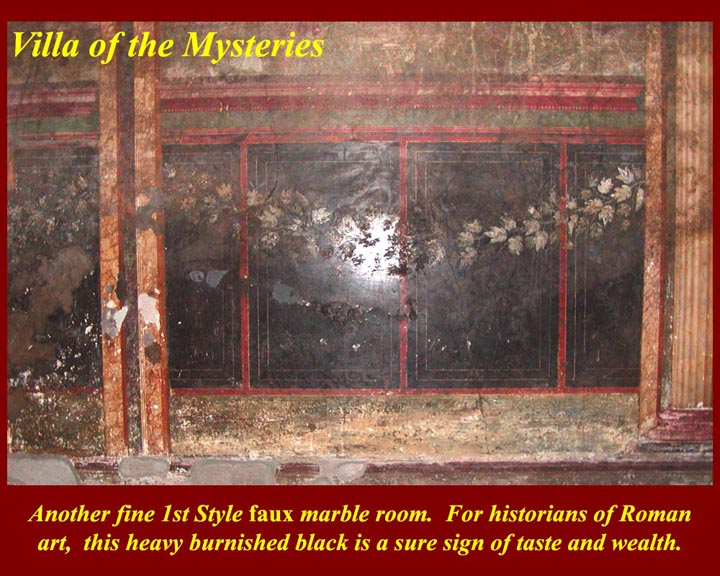
http://www.mmdtkw.org/ALRIVes0510BurnishedBlkGarlands.jpg
The Villa of the Mysteries was lavishly and expensively decorated. Burnished black walls like these have always been associated with great wealth. These were probably part of the post earthquake remodeling, and are in the eclectic "fourth style".
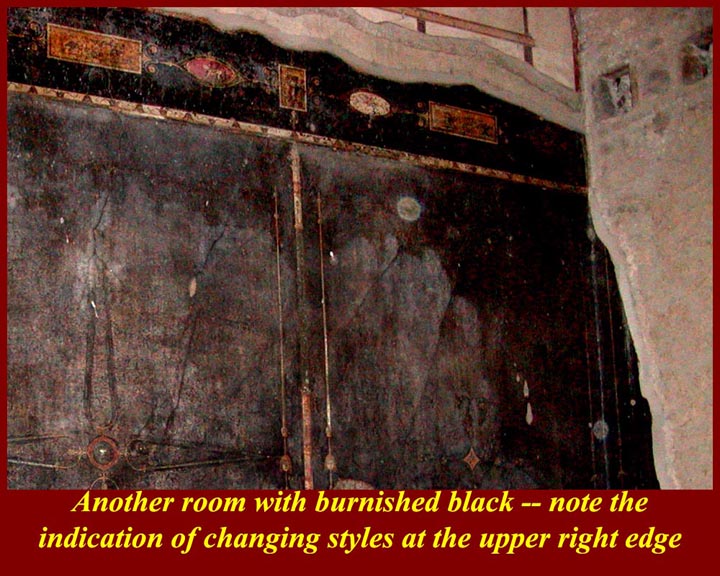
http://www.mmdtkw.org/ALRIVes0511Black-ChangeStyles.jpg
Another room with black burnished walls, these with including crossed geometric incisions. The small medallions at the intersections have painted miniature scenes as do the ovals and frames above the black panels. This is also fourth style, and at the upper edge and on the perpendicular side wall are visible the remains of earlier "second style" frescoes. There appears to be an intermediate layer, but its style in not determinable.
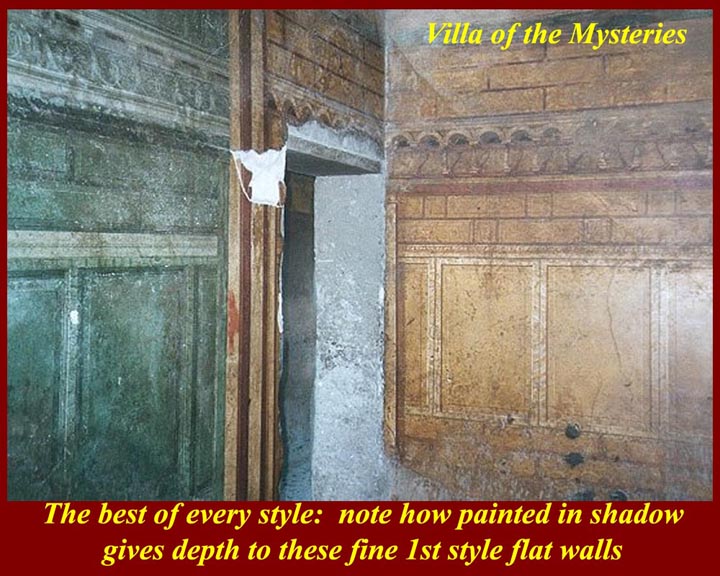
http://www.mmdtkw.org/ALRIVes0512FirstStyleDepth.jpg
Bright and shiny new looking "first style" decoration -- actually shading a little bit into "second style". There was a continuum here also. The walls are flat, and the impression of depth is provided only by manipulation of shadow within the fresco work. The artists had total command of perspective. The four styles are no longer considered to be strictly sequential. Different styles could be applied simultaneously and even in reverse or jumbled sequence in different rooms of the same house, just as we might decorate different parts of our own houses today -- we might have a "formal" dining room, plain bedrooms, and a Spanish colonial family room. In big Roman houses there might be multiple "theme" rooms for entertaining guests or for private activities. This villa had multiple large and small entertainment spaces is several different themes. (Slave and servant areas -- work and living spaces -- would not be decorated as lavishly if at all.
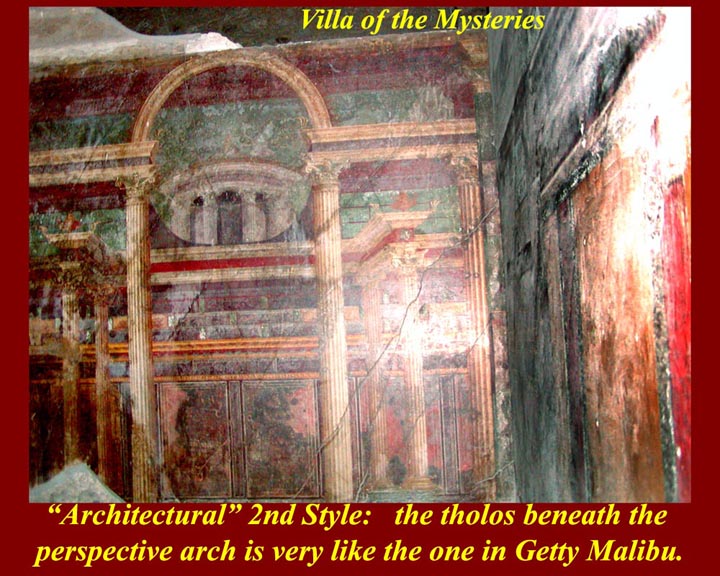
http://www.mmdtkw.org/ALRIVes0513Archtectural2ndStyle.jpg
This is very complex "second style" -- overlapping architectural elements all frescoed on flat walls. The tholos under the arch is very similar to the one on the "wall of the tholos" in the Getty Museum in Malibu, but the overall effect here is much deeper. The idea is, of course to add apparently endless vistas to inside rooms.
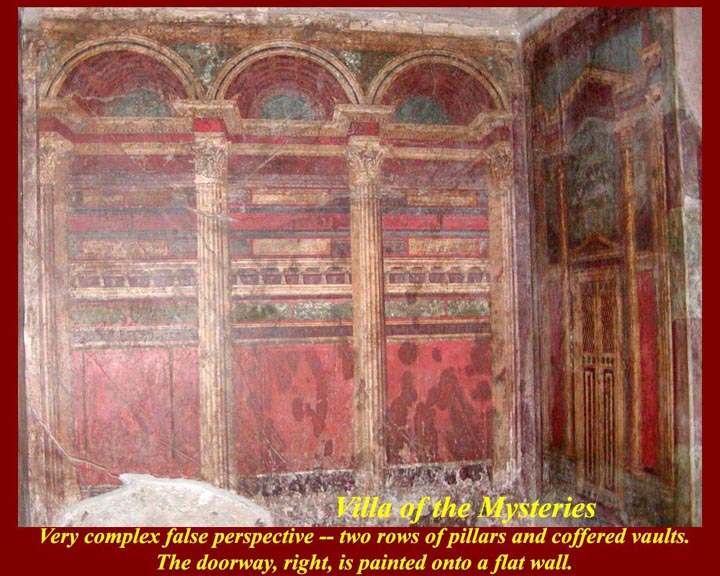
http://www.mmdtkw.org/ALRIVes0514FalsePerspective-Door.jpg
Here, false perspective is again used to "extend" a room which has the appearance of double trabeated columns overarched with coffered vaults, the ends of which are open to the outside. But it's all illusion as is the doorway on the right wall, which is simple painted on a flat surface.
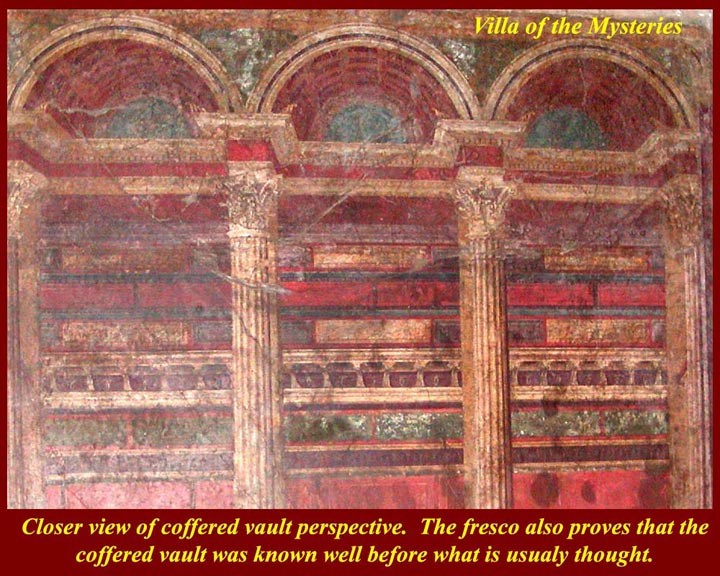
http://www.mmdtkw.org/ALRIVes0515CofferVaultsFresco.jpg
This is a closer view of the same wall, included to show the perspective of the coffered vaults, the trabeation, and the pillars. It's all very well done, but the important part is the pictured coffering, which indicates a much earlier command of the coffering technique than otherwise might be expected. The weight saving method was especially suited to concrete vaults and domes, and it was used on a grand scale a century and more later in Rome's huge baths, in the Basilica of Maxentius in the Roman forum, and especially in the pantheon which was the largest concrete dome ever built until the middle of the 20th century (and the 20th century dome, unlike the Pantheon, had steel reinforcement).
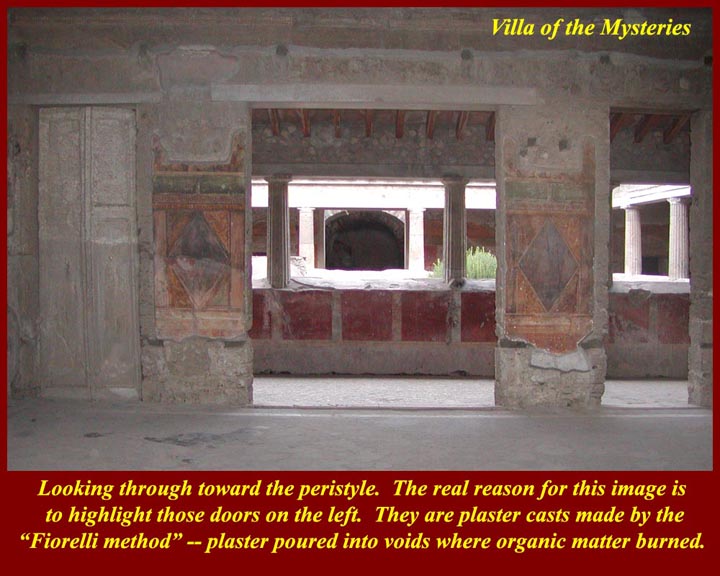
http://www.mmdtkw.org/ALRIVes0516FiorelliDoors1.jpg
The view from the tablinium and across the atrium toward the peristyle. There was a wide central doorway flanked by two narrower doors. What looks like a bi-fold door on the left is really a plaster replica made by the "Fiorelli method" of pouring plaster into a void caused by the disintegration of organic matter.
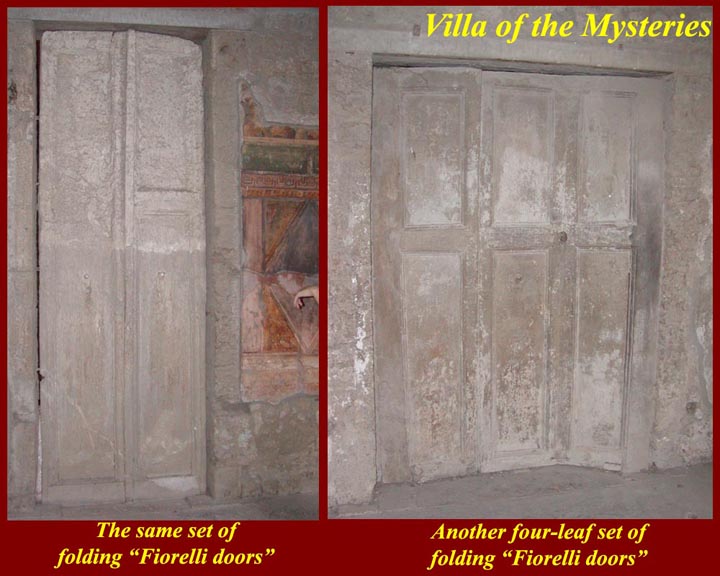
http://www.mmdtkw.org/ALRIVes0517FiorelliDoors2.jpg
The same bi-fold door, and a slightly unhinged four-leaved model. There are several more around the Villa: folding doors of this kind appear to have been fairly common, and they were certainly much used to cover wide storefronts in towns. The storefront models were more heavily built for security and the whole assemblage could often slide into a side niche so as not to take up any of the display or service area.
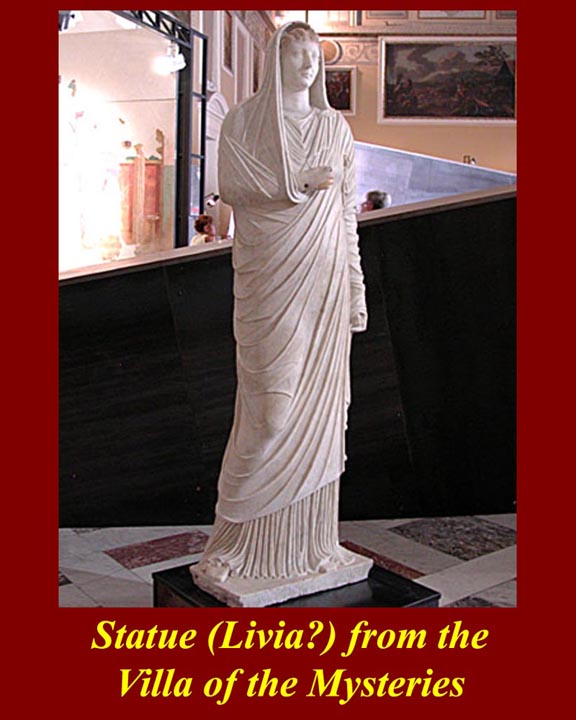
http://www.mmdtkw.org/ALRIVes0518LiviaMatron.jpg
This statue, now in the Naples Archeological Museum, was found in the Villa of the Mysteries. It is usually identified as Livia, the wife of Augustus because of its similarity to other portrait statues identified as Livia. The costume, and particularly the scarf over the top of the head, makes it a "priestess" statue in modern archeological parlance, although any matron would be so attired at prayer -- it is assumed that only a priestess would rate a statue.
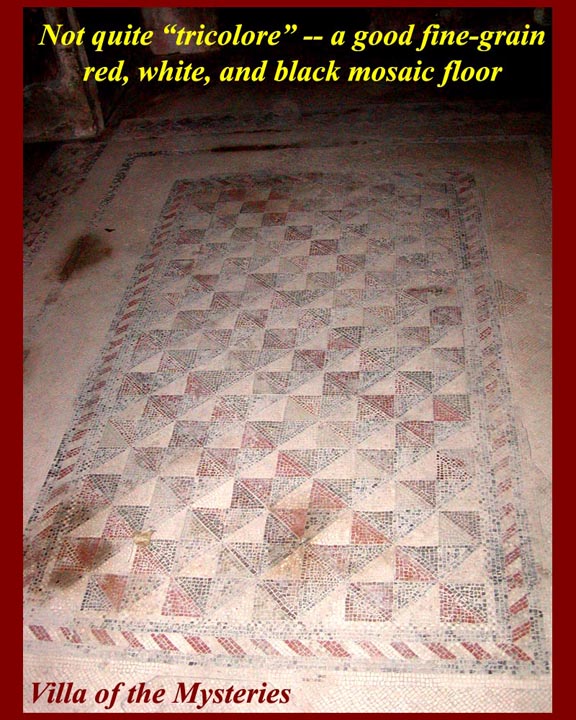
http://www.mmdtkw.org/ALRIVes0519NQTricoloreMosaic.jpg
A well preserved three color geometric mosaic floor -- three colors, but not quite the Italian flag "triclore" which is red, white, and green.
The Italian "tricolore" flag has the same colors as those of the ingredients that are used in Pizza Margherita -- tomatoes, basil and Mozzarella cheese. A version of pizza with those ingreients was legendarily presented to and named after Italy's Margherita of Savoy (Margherita Maria Teresa Giovanna; 20 November 1851 Ð 4 January 1926) who was the Queen consort of the Kingdom of Italy by marriage to Umberto I. The Pizza is not to be confused with Palazzo Margherita, also named after the Queen Dowagers, which is now the main building of the American Embassy in Rome and was the Queen's official residence until she died. Another building on the Palazzo Margharita grounds was General Patton's HQ in Rome.
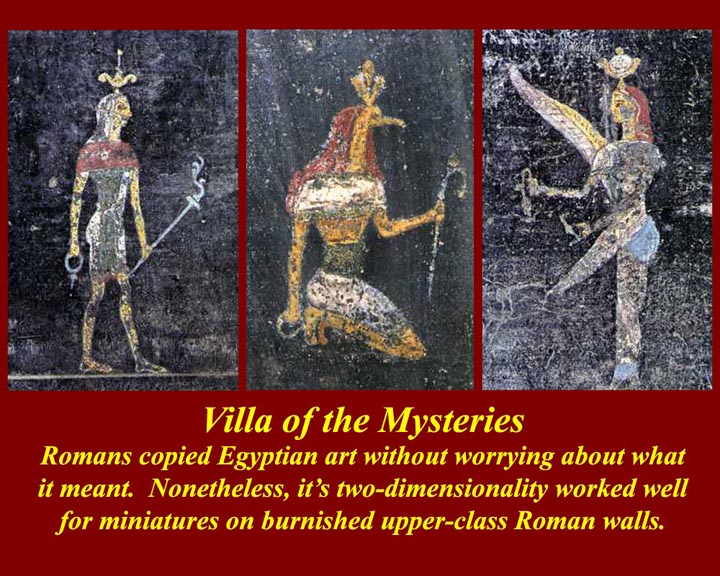
http://www.mmdtkw.org/ALRIVes0520Egyptianisation.jpg
As noted above, the Villa of the Mysteries has entertainment rooms decorated in particular themes. This one is Egyptian, and again on an expensive background of burnished black. (The cost of room background colors, from dearest to cheapest, is thought to be as follows: black, dark blue or brown, red or yellow, white. This villa has a lot of black.) Except in temples of Isis and Isis priestly quarters, there appears to be no knowledge or care about what is shown in "Egyptian" rooms: temples and priestly quarters presumably had real imported Egyptian priests to keep things honest. "Egyptianisme" was regaining its popularity after falling into disrepute because of the affairs of Julius Caesar and Mark Anthony with that foreign hussy, Cleopatra. At about the same time this room was decorated (after the 60s earthquakes), Nero caused another obelisk to be shipped from the Alexandria port to to decorate the spina of his new circus on the Vatican Hill, and, as we have seen, the Isis mystery cult was very popular in Pompeii.
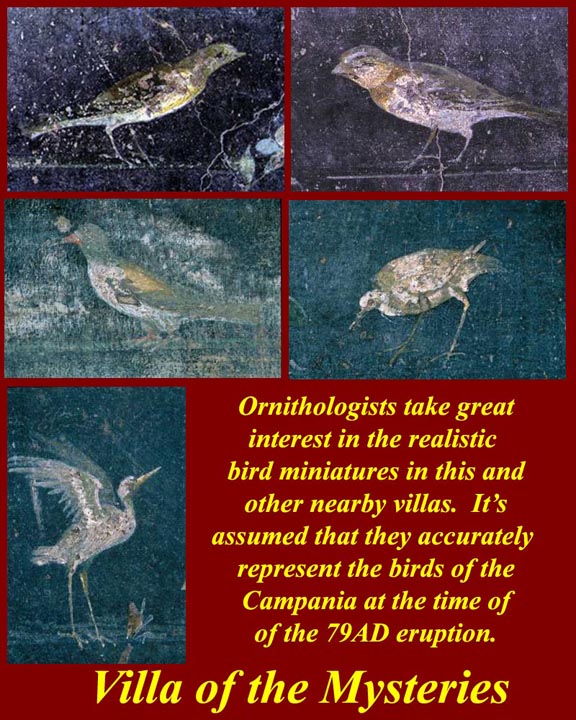
http://www.mmdtkw.org/ALRIVes0521BirdMiniatures.jpg
There were also birds -- a fact for which paleo-ornithologists are suitably grateful. All that I, a non-ornithologist, can determine is that the two with the long legs are water birds.
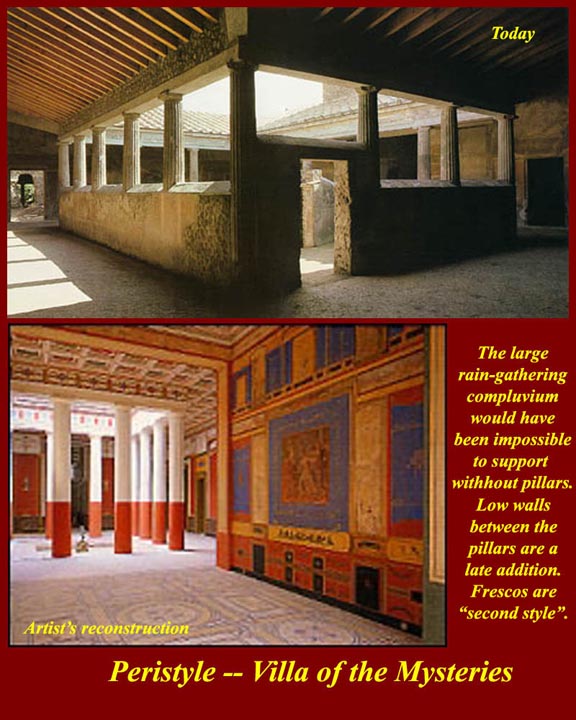
http://www.mmdtkw.org/ALRIVes0522PeristyleMysteries.jpg
The peristyle changed its aspect as the complex went through its phases. The top view is what was excavated, with the addition of a new roof. Note that although the roof was replicated, the flat ceiling below the roof was not. The lower view is how the peristyle looked in an earlier phase. At some point a stone roofed stairway down into the cryptoporticus below the platform was added inside the peristyle. Its purpose was, it is thought, to service the wine fermentation and storage areas that were built into the cryptoporticus when the winery was added to the villa.
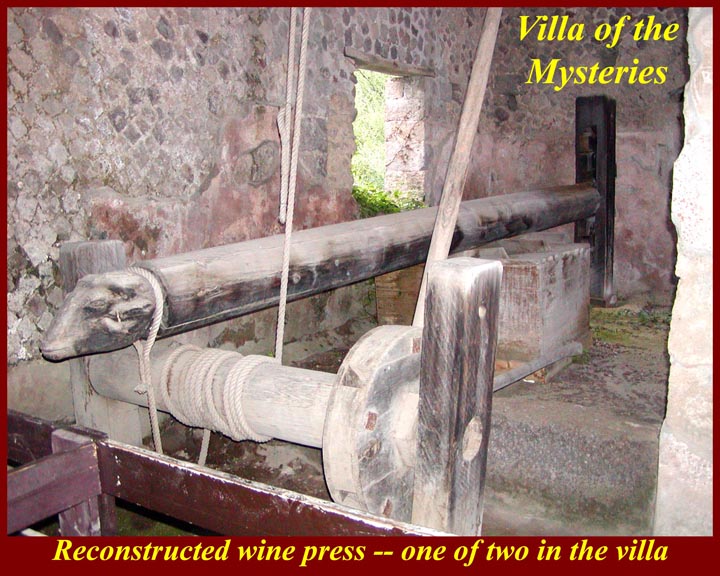
http://www.mmdtkw.org/ALRIVes0523WinePress.jpg
In the 'working' section of the Villa, there is this wine-pressing room (torcularium) where there is a reconstructed grape press. The lever arm (the "torque' in torcularium) was an oak trunk with a carved ram's head (ariete). The juice flowed down a duct into the cellar below, where it was stored in huge pitch-lined terracotta jars (dolia) set into the floor. In ancient times there were two presses in the room, each of which had "double action" machinery. The capstans could lift the levers to allow the crushing chambers (the square boxy thing) to be filled but they could also pull the levers down to to add force to the crushing weight of the press-stone and the lever itself. The flat area between this box and the other one on the other side of the room was the treading floor. The pivot, adjustable with wedges, is on the far wall.

http://www.mmdtkw.org/ALRIVes0524WineryVillaMysteries.jpg
A schematic of the torcularium room and associated fixtures, but it doesn't show much of the storage area in the cryptoporticus and cellars, parts of which have not been excavated.
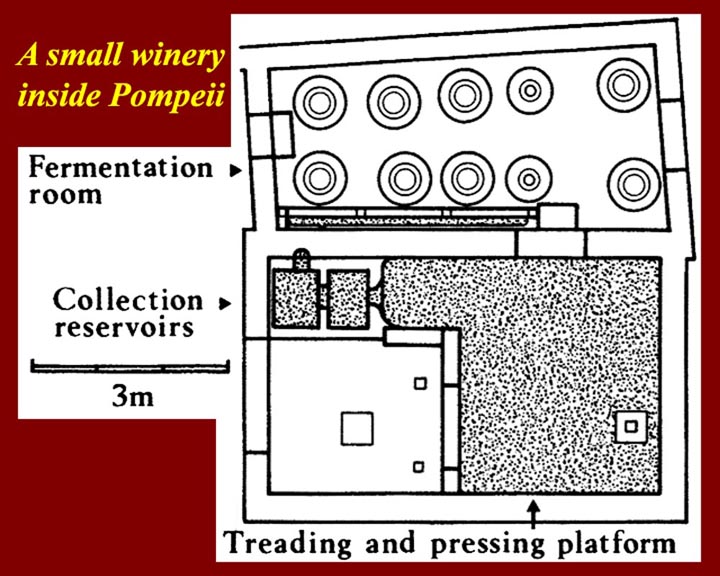
http://www.mmdtkw.org/ALRIVes0525PompeiiWinery.jpg
This is a much smaller winery inside the walls of Pompeii. Until the time of the 79 AD eruption, Pompeii wines were considered to be the best in the empire -- when the Pompeii and Vesuvius vineyards were buried, Falernian, from the northern fringe of the Campi Flegrei, also in the Campania became the most desired Roman wine. There are Pompeii, Vesuvian, and Falernian wines on the market today, but nobody knows if they have the authentic taste of the ancient wines. Oenologists have studied what remains in the bottom of ancient jugs that have been dug up and have even found some liquids in pitch-lined amphorae in shipwrecks and have used these remains to try to duplicate ancient wines, but it's all guesswork. At any rate, cultured Romans drank their wines differently than we do. It was considered uncivilized to drink unwatered wine, and wine was often heavily flavored and spiced (in addition to the pine-pitch that some lined storage jars, which probably gave "authentic" ancient wines a "retsina" taste). Wine also might be served chilled, room temperature, or heated. At orgies (which were food and wine feasts, not what you think) there would be a master-of-ceremonies who set the order and additives and watering rate of the wines. Finally, some wines were stored in lead or lead-lined tanks, and wine, being acidic, would have quickly become contaminated by lead salts leached from the tanks -- lead salts would have sweetened the taste of lead aged wines.
Excess in food and drink consumption was entirely disapproved, and public drunkenness was a sign of weakness and would cause disgrace (which was a major factor with Mark Anthony's reputation and later with Claudius.)
The old wheeze about bulimic throat-tickling and quick trips to the "vomitorium" is a modern (1923) misinterpretation that the Oxford English Dictionary lays at the feet of Aldus Huxley. The Romans knew about mealtime excess and vomit, but it was tres declasse. After a meal, however, if you were in distress, whether from overeating, drinking, or otherwise, it was considered wise to use an emetic, both because it was considered silly to remain in distress and because inadvertent poisoning was always a worry.
Vomitoria, by the way, really were only exits from public venues like theaters or amphitheaters, built in multiples to allow quick dispersal of agitated audiences. The Colosseum in Rome had eighty vomitoria, seventy-six of which were for the general public. Magistrates bragged that the Colosseum routinely emptied and the crowds dispersed to their homes in under fifteen minutes.
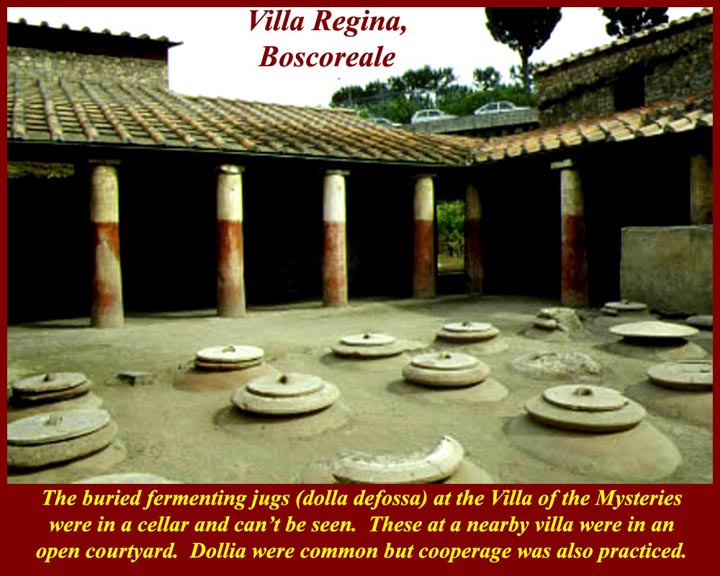
http://www.mmdtkw.org/ALRIVes0526DolliaDefossa.jpg
This set of dolia defossa (big jugs, buried) was used for fermentation at a nearby villa. The main fermentation area at the Villa of the Mysteries is a still-buried mystery. The dolia were lined with pitch -- by which the Romans meant pine-tar, so wine fermented and stored this way would surely have had a "retsina" taste. From Silenus statues it's clear that wine at some point in history was also carried in "wineskins" which also would have been lined with pitch, as are authentic Spanish bota bottles -- the inauthentic ones have latex or plastic liners and the wine tastes better. Eventually the Romans started using metal tanks instead of pitch-lined dolia, but the first ones were lead, and you can bet that didn't improve their health.
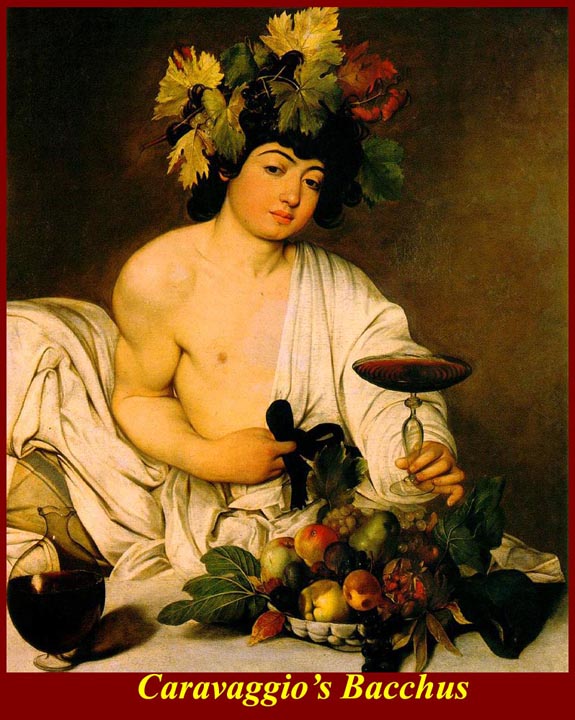
http://www.mmdtkw.org/ALRIVes0527BacchusCaravaggio.jpg
The "Mystery" that everyone talks about in the Villa of the Mysteries is the "Mystery" cult of Dionysus (Dionysos in Greek). Etymology: the Greek word < mysta > simply meant "priest". A mystery religion or cult was one in which part or all of the knowledge or ritual was known only by or was reserved to the priesthood. Mystery temples had a section inside the cella called the mysterium (mysterion in Greek) where only the priests were allowed and where they performed secret rituals. Some of the early cults in the pre-Roman Italian peninsula had this mysterious aspect, but they were mostly subsumed into more sophisticated Greek cults. The Dionysos cult was also a Greek import, but because of its wild and contrarian nature it was not subject to gradual sophistication. The more "standard" or orthodox Roman and Greek "pagan" cults, on the contrary, were usually quite open and public. Their ritual sacrifices were performed at altars outside, in front of the temples. Traditional Romans -- i.e., pagan conservatives -- had a great distrust for the "new" religions arriving mostly from what we would call the Middle-East because of their secrecy.
But new "mysterious" cults did arrive and became popular, and then they became more popular as Romans became bored with their "old time religion". The new mystery cults included that of Isis, the Mithra cult, the cult of Dionysos, the Orphic cults (more than one), the Cybele cult with its self-castrated priests, and Judaism and Christianity. The latter two, which were long considered identical by the Roman authorities, had closed ceremonies which only the priests were allowed to see. Western Christianity lost its "mystery" when it abandoned the iconostasis, and Judaism without a temple (i.e., "Rabbi/synagog Judaism", as opposed to High-Priest/temple Judaism) was also no longer "mysterious". The Roman urban core, the city itself, was slower to adopt these new religions, but outlying areas, and especially areas like the Campania and the Bay of Naples, which had many more foreign trade contacts and alien residents, saw much earlier adoption of the mystery religions. In the eastern provinces, where most of the "mysteries" originated, they always had a strong foothold, and in the western provinces -- less "civilized" and therefore under tighter military control -- the Mithraic cult gained ground quickly, because that exclusively male cult was very popular in the military rank and file.
Bacchus was another name for Dionysus, and some sources say that the Bacchus name was originally onomatopoeic and referred to drunken shouting (two kinds: iacchus et bacchus, which, we think, was loud raucous laughter and doglike barking of Dionysus adherents -- the words raucous, laughter, and barking may all well be onomatopoeic as were iaccgus and bacchis)). Dionysos in art is usually soft, often young and effeminate (but sometimes old and fat), always with wine and grapes at hand. He was the god of wine, fertility, and excess and was much loved in the Campania where he was also a "patron saint" of the Vineyards and wineries.
In the early days of his cult, the rituals were limited to women, and men approached only at their ultimate peril. According to many contemporary and subsequent accounts, the women drank and danced themselves into a frenzy and then tore apart and ate raw animals associated with virility -- rams, bulls, cocks, and any stray men who might wander in. In later days in Rome, Bacchus rituals became co-ed and the famous Bacchanalia resulted. This was after Bacchus had become totally identified with -- merged with -- Libertus, the Roman god of moral license. The initiation ritual for female "Bacchantes" is thought to have stayed pretty much the same (although the only pictorial representation we have of the ritual is from one room of the Villa of the Mysteries.
It's appropriate that a female initiation rite would be pictured in a Villa with a winery. It's most often assumed that the initiate would have been a wife or daughter of the house, but it's also possible that the frescoes were simply homage to the god who protected the livelihood of the establishment. Or both.
This young Dionysus/Bacchus image, of a painting by Caravaggio, is one of the more famous of the Renaissance. Caravaggio was himself said to be enamored of young effeminate males. The model for the painting us tentatively identified as Cecco del Caravaggio. See https://en.wikipedia.org/wiki/Cecco_del_Caravaggio. This Caravaggio Bacchus is in the Uffizi Gallery in Florence, Italy.
Caravaggio is all over the Internet, but one article I particularly like is at http://www.mmdtkw.org/VCaravaggio.html -- it's by me.
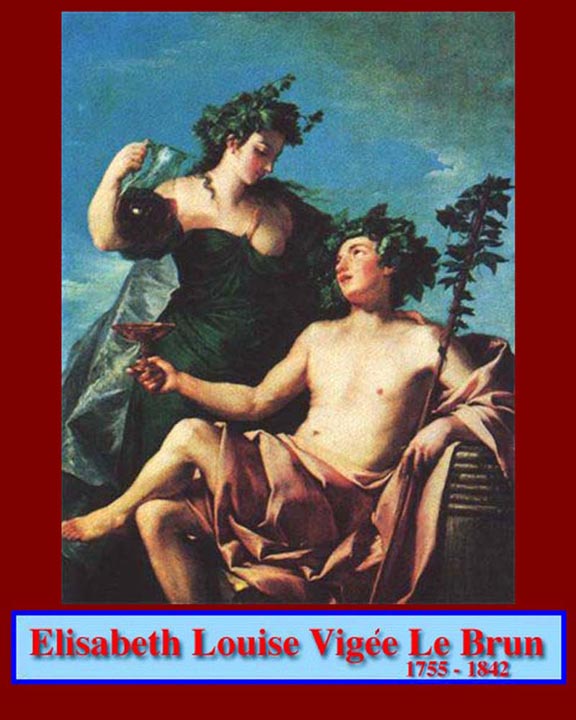
http://www.mmdtkw.org/ALRIVes0528BacchusLeBrun.jpg
From Bulfinches Mythology:
The image is of Dionysos with Ariadne. The artist, Elisabeth Louise Vigee Le Brun, although not well known today, was the most popular European portrait artist of her day. She was the court artist at Versailles during the reign of Louis XIV and painted everyone who was anyone -- including thirty known portraits of her friend Marie Antoinette. She survived the Revolution and spent twelve year as a peripatetic artistic exile in Europe during which time she expanded her portfolio of European royals and aristocrats. Eventually she was taken off the rolls of wanted emigres and allowed to return to Paris. The portfolio, by the time of her death in Paris in 1842, included over 900 known works, some 700 of which were portraits. Everything that is known about her seems to be on the Internet. Just look up her name using any search engine (Google, etc.).
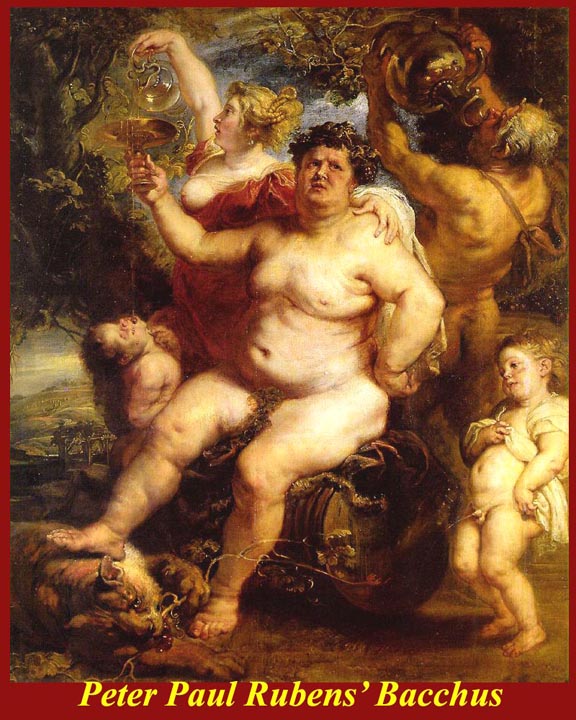
http://www.mmdtkw.org/ALRIVes0529BacchusRubens.jpg
Peter Paul Rubens here shows what can happen when excess is taken to excess. Bacchus and Ariadne have reached vastly overweight middle age and have not yet thought about dieting. The kids are moving in the same direction, and even the lion that Dionysus/Bacchus rode in his youth is "round and on the ground." Rubens also can be found all over the Internet including at http://www.artchive.com/artchive/R/rubens.html. Critics said Rubens always painted himself.
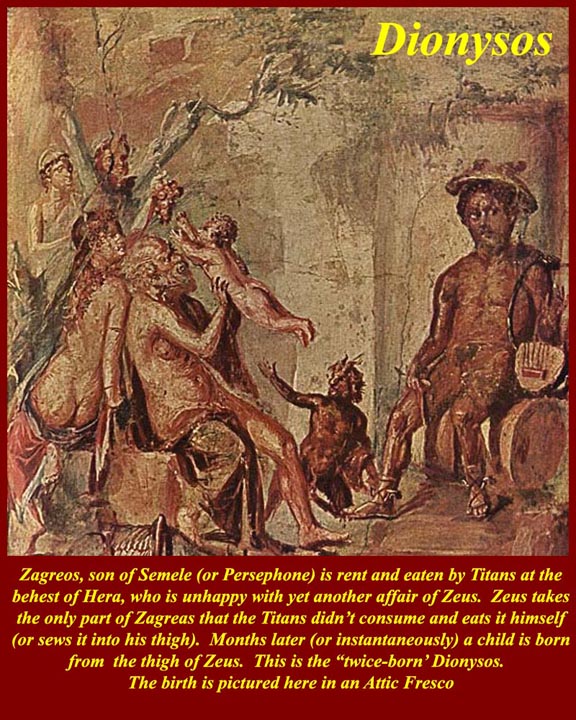
http://www.mmdtkw.org/ALRIVes0530dionysos's_birth.jpg
The artist of this ancient Greek fresco is unknown. It shows the second birth of Dionysos, a name that means "Twice Born". According to the most common versions of the Dionysos myth a child named Zagreos was born of Semele after Zeus in the guise of a python snake had an affair with her. Hera, as usual, was infuriated by Zeus's infidelity and had her friends, the Titans, dismember and eat the boy. They somehow left his heart uneaten, and Zeus retrieved it. Zeus either ate the heart himself or sewed it into his thigh, and, after some interval, gave the boy his second birth by cutting him out of his thigh. (It helps to know here that prudish European translators always translated as "thigh" the Greek word that really means "crotch"). Zagreos, now Dionysos, appropriately becomes the god of fertility, of abandon, and especially of wine, which is regarded by many as an aid to fertility and abandon.
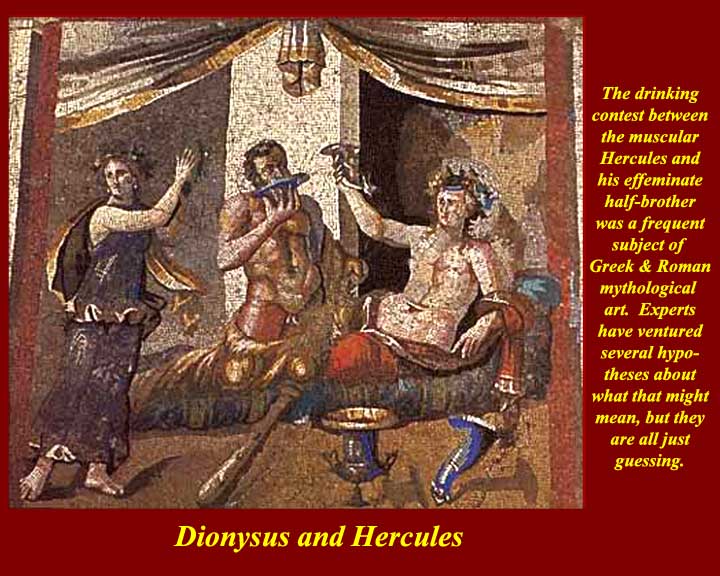
http://www.mmdtkw.org/ALRIVes0531DionysosHerculesMosaic.jpg
Zeus was a master of disguise: he was the Swan who seduced Leda, the Bull who frolicked with Europa, the Snake who snuck into bed with Semele to produce Zagreos, and he was several other things that fooled several other women. His least common disguise was that of a man, but that's just what he did when he put on the skin of Amphitryon to seduce Alcmene. The real Amphitryon had just left his marital bed. When his wife produced very dissimilar twins it was clear what had happened: Iphicles was the son of Amphitryon, and his robust brother, Hercules, was the son of Zeus. Once again, Hera, the one and only wife of Zeus, sought revenge against the already-sinned-against mother and her innocent child. Hercules strangled the snakes she sent against them and survived to become the great hero of the big and small (but getting ever bigger) screens. With a common background, it was inevitable that Hercules and Dionysos would be friendly rivals. What they both apparently best liked to do was have drinking contests. The image shows a Greek mosaic that was often copied in the Greco-Roman world -- or perhaps it's just the oldest known copy of an earlier work. Although the two men are identified in several iterations of the image, I'm not aware of any that of the images identify the woman.
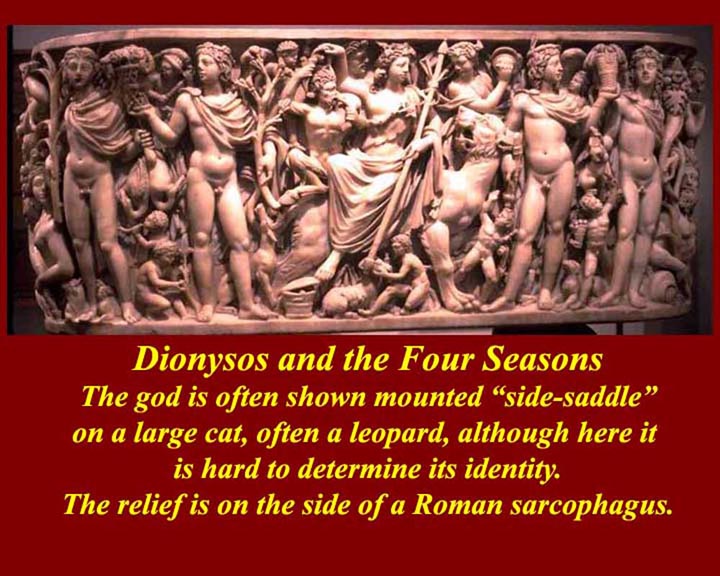
http://www.mmdtkw.org/ALRIVes0532Dionysos4SeasonsSarcophagus.jpg
A common scene on Roman sarcophagi is a young Dionysos side-saddle on a big cat -- sometimes a lion and sometimes a leopard -- and surrounded by the personified Four Seasons. Experts say that the meaning is the obvious one: it's always a good time for a glass of wine. It also refers, they say, to the all-season work that is required to make a good wine.
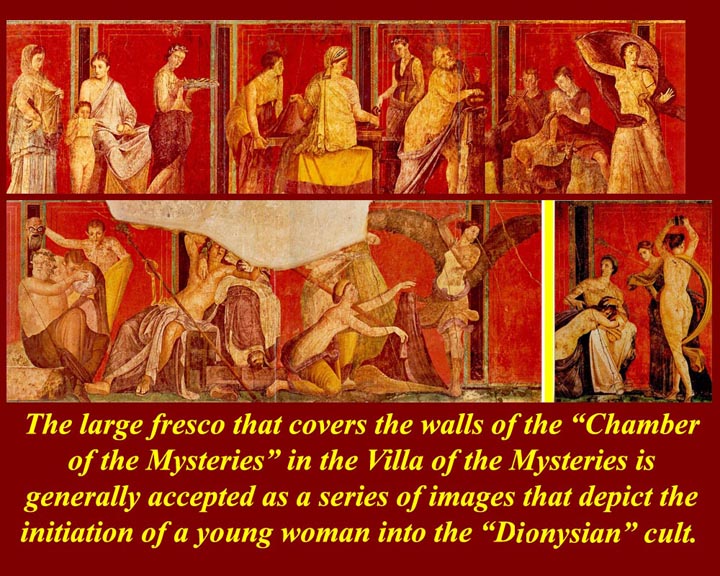
http://www.mmdtkw.org/ALRIVes0533MysteryFresco.jpg
We finally get to the Dionysus cult initiation fresco in the Villa of the Mysteries. The images are bigger than life-size (assuming your not an outsized athlete) and have been variously interpreted as a number of scenes of one woman's initiation or scenes of a number of women being initiated. Everyone agrees that it's the Dionysian cult that she/they are joining. This was not always the case: these images provoked a search of Mediterranean art for analogs that made the identification certain. It's also universally agreed that this cycle of frescoes is the most complete and perhaps the only full depiction of the initiation ceremony that has been seen anywhere. Since their is almost complete silence about Dionysian initiation in the ancient written literature this has become the standard source on the subject. Like much else in the Villa of the Mysteries, it appears that these frescoes were completed as part of the post-earthquake redecoration and that they were almost immediately placed in "hot storage" by the 79 AD eruption.
Note that unlike the Christian, Isis, Mithraic, and Orphic cults (the last being a more austere form of Dionysos cult) the Dionysos cult left behind no known "scriptures" and little in the form of pictorial representation, so there is a lot of guesswork in the interpretation of Dionysos rituals.
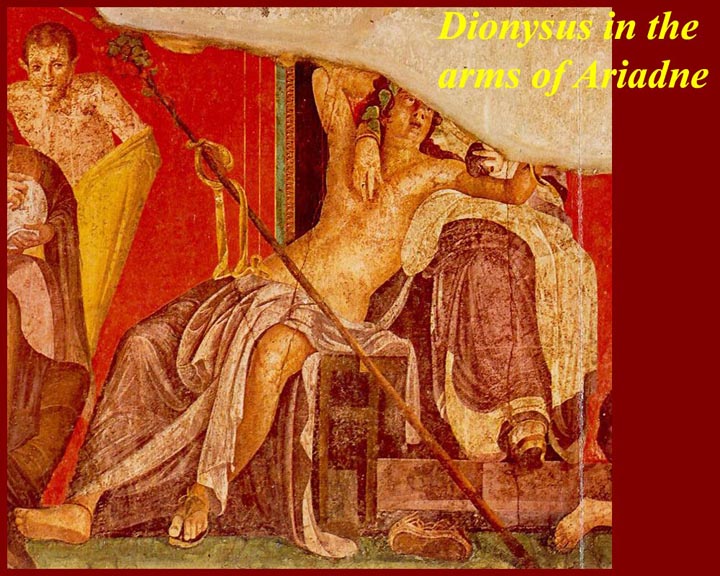
http://www.mmdtkw.org/ALRIVes0534DionysusAriadne.jpg
Unfortunately, the the participants of this central scene in the initiation fresco at the Villa of the Mysteries are both damaged and not named in the fresco. Most experts, basing their judgments on analogous images with named characters, now say that the woman in the fresco is Ariadne. The long staff is a thyrsus which is one of the "attributes" of Dionysos, a symbol that is considered to have been included in his images to make them easily identifiable. The Dionysian thyrsus is a long staff tipped with a cone of a pinion pine, that same famous Italian and Plinian "umbrella pine". The staff is often beribboned or wound with vines, often ivy. A more general definition of a thyrsus would include any bunch of seed pods or flowers. It's thought that the word is related to the sound that would be made if a thyrsus was shaken, so the word is often associated with anything that is shaken for sound. The word is also used in botany. The long shaft clearly also has phallic significance. And just look at the shape and position of the ribbon in this picture.
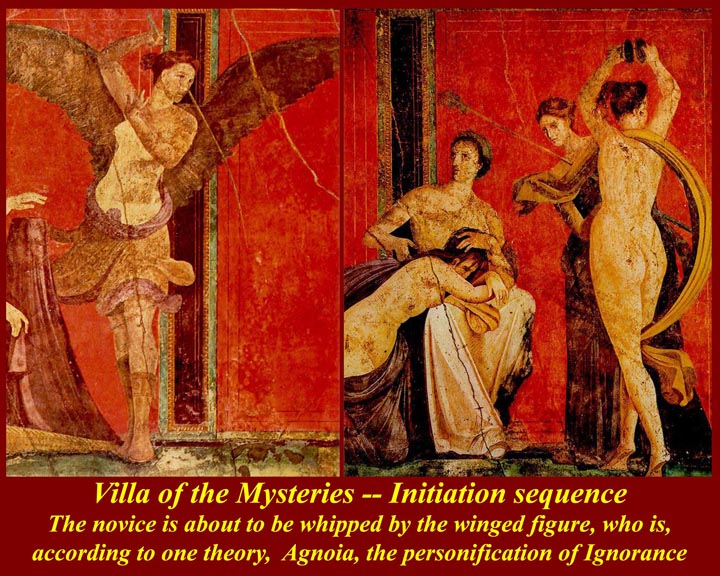
http://www.mmdtkw.org/ALRIVes0535Flagellation-Mysteries.jpg
This is the third "scene" depicted in the fresco and it takes place after the initiate enters (scene 1) and disrobes/prepares for the initiation (2). In this scene a winged figure, sometimes identified as Agnoia (Ignorance) is flogging or preparing to flog the initiate while another naked figure dances. Various theories are advanced for the meaning of the scene: a feminist version says it depicts the subservient and downtrodden state of ancient womanhood and that its very depiction is a rebellion against this state; a realist interpretation is that candidates for initiation were actually flogged during the ritual; a "figurative" view states that the initiate would not really be flogged (the figure with the whip is, after all, depicted as a mythical spirit) but that she is beset by ignorance which she will shed by becoming a full member of the cult. The dancing figure is sometimes described as the same initiate celebrating (or anticipating) her freedom from ignorance. Others say she is a different girl who is already a member of the cult and is encouraging the new initiate by showing her that her new religion will liberate her. The swirling cloth over the shoulder of the dancer is an artistic attribute of a Dionysian ecstatic or entranced Bacchante.
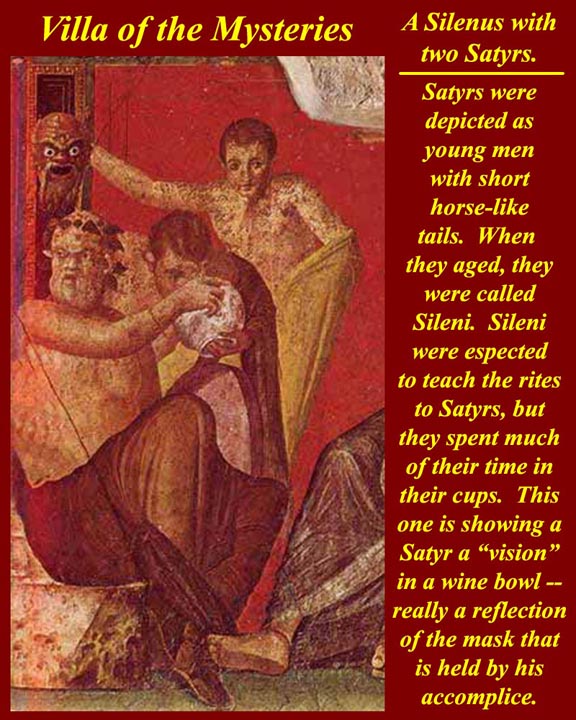
http://www.mmdtkw.org/ALRIVes0536SilenusSatyrsVision.jpg
There are males in the fresco but they fall into three categories: (1) pre-pubescent children, (2) satyrs, who are not completely human and have short horse tails and pointed ears, and (3) Silenoi, satyrs who have aged. Silenoi are supposed to supervise the Satyrs who are there to assist in the ceremonies as needed, but, in fact, the Silenoi spend much of their time drunk or asleep or playing tricks. Here, a Silenus has enticed a Satyr to look into a bowl to see a reflection -- a vision -- in the liquid, which here would be wine. The Satyr peers in, not knowing that the accomplice of the Silenus is holding a mask behind him, the reflection of which he will see in the trembling bowl. "Theatrical" masks (comedy and tragedy) developed from masks used in Dionysos rituals, and many sources say that theater itself developed from the frenzied choric hymns and dances (dithyramboi) that the ancient Greeks performed in honor if Dionysius. (A dithyramb, technically, is an antiphonal performance by two groups of singers or by a leader and a chorus.)
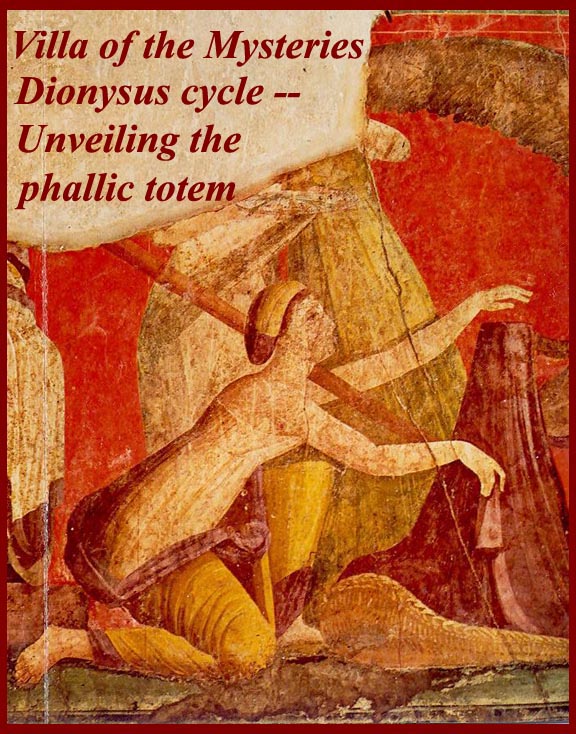
http://www.mmdtkw.org/ALRIVes0537PhallicTotem.jpg
The most common image in Dionysos art is the moment in which an initiate lifts the double veil from the phallic totem. It is often shown as just a long smooth stone, but it can also be quite realistic. In times past you could buy one of the realistic type from young boys and old men (Satyrs and Silenoi?) that hung out around the Villa entrances, but there were none to be seen when I last visited the site a few years ago. It was a rainy day, so they just may have stayed home. Here our initiate is lifting the final veil, but has not yet exposed the phallus. In some other images she is in the same pose and has already lifted the last veil, but what is exposed is one of these "theatrical" masks rather than a phallus. Theories have been advanced as to why, but they are all just guesswork.
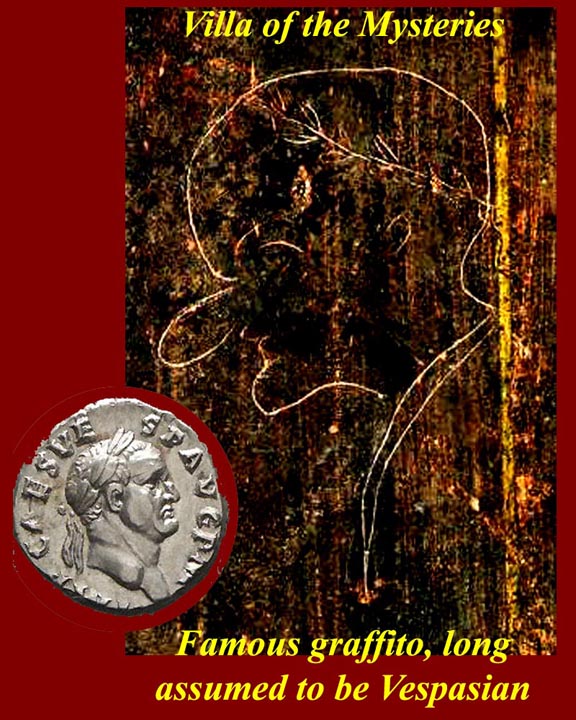
http://www.mmdtkw.org/ALRIVes0538VillaMysteriesGraffito.jpg
One of Pompeii's most famous graffito caricatures, and not just because of its remarkable resemblance to Mr. Magoo or LBJ, was uncovered in the Villa of the Mysteries. Its discovery and, ever so much more so, its making long predated both Magoo and LBG. It has long been thought to represent Vespasian who died peacefully at Aquae Cutiliae near his birthplace in Sabine country on 23 June, 79 AD, after contracting a brief illness, often said to have been dysentery. A month later, his son and successor visited Pompeii to dedicate a new altar in front of the temple of the Imperial Cult in the forum, and just a month after that came the big Vesuvius eruption. Portrait and coins of Vespasian show a tightly contracted face, which, his enemies said, made him look permanently constipated. Ironic that he may have died of the opposite.

http://www.mmdtkw.org/ALRIVes0501Villa_Rustica-a.jpg
Ancient Roman villas were country homes, and they spanned a continuum from simple farm houses through huge complexes that may or may not have any agricultural purposes. The simplest form, illustrated above, has a house with two connected rooms and another separate room beside them. Inside the walls and behind the house is a small garden. There is a small partly shaded area (call it a patio?) in front of the house and in front of that a farmyard where animals could be corralled. Side rooms off the farmyard could shelter animals or slaves or could be used for storage of tools or products. The whole structure is walled for security -- enemies or bandits come to mind -- and fields, pastures, etc. would expand outward.

http://www.mmdtkw.org/ALRIVes0502HadrianVilla.jpg
The other end of the continuum is Hadrian's Villa (Villa Adriana) in Tiburtina, now Tivoli, about forty-five minutes east of Rome by car. It had pools, baths, two theaters, entertainment areas, and everything else an emperor might desire. Many features were modeled after things Hadrian saw in his extensive travels. He traveled so much, in fact that he seldom had the opportunity to enjoy his country home. Complexes of this size would always be under continuous construction and reconstruction, but architects and archeologist nonetheless say that it was "completed" shortly before Hadrian's death in 138 AD. There are no agricultural production areas (presses, carding rooms, etc.) although tools consistent with floriculture, arboriculture, and kitchen gardening were found. Imperial real estate would have included productive farms either adjacent of elsewhere, under management of subordinates -- probably imperial freedmen and slave overseers. This site has nothing to do, of course, with Pompeii/Vesuvius, etc., but it's included to show the range of possible villa establishments.

http://www.mmdtkw.org/ALRIVes0503LaterRomanVillas.jpg
Roman and Roman type villas spread throughout the empire and beyond and also down through the centuries. Prior civilizations also had their agricultural establishments and ex-urban estates, but the Romans seem to have, from our perspective, gotten it just right: we all yearn for that big country estate to which we could retire -- with, of course ample servants and currency to keep it fun. Our aspirations are not accidental. Our own "forefathers" (the word translates exactly with patricians) built country estates modeled after those big ancient Roman villas as they had been envisioned by Renaissance and English and French interpreters. "Provincial" villas almost always had agricultural as well as representational functions. And that includes, of course, those in Virginia. The Image shows artistic representations ancient villas in Britain, France, and Germany in the period of their Roman occupation and photographs of Mount Vernon and Monticello in Virginia.

http://www.mmdtkw.org/ALRIVes0504VillaMyst.jpg
Our primary subject matter for this unit is the Villa of the Mysteries, which is located on the road that archeologists have dubbed the Street of the Tombs: it ran out of Pompeii through the Herculaneum Gate. There were two other suburban properties between the gate and the Villa of the Mysteries, which have been denominated by their excavators as the Villa of Cicero and the Villa of Diomedes. Being on the side of the city toward Vesuvius, they were buried deep in ash before taking the brunt of the pyroclastic surges/flows that crashed down the volcano's slopes. Although the Villa of the Mysteries was built on a high artificial platform on the slope of the volcano, it was completely covered by the debris: the current ground level is above the level of the top of the villa (including the 20th century roofs that were added to protect excavated wall art.) The Villa complex dates from the 2nd century BC but also includes important renovations and expansions from around 60 BC and again in the first half of the 1st century AD. It was seriously damaged during the earthquakes of the 60s AD and was still being repaired when it was overwhelmed by the eruption of 79 AD. The Villa is also known as the Villa Item (after the owners of the property on which it was excavated). Most of the excavation was done by Maiuri in the 20th century -- he was fascinated by the Dionysian mystery mural and turned it into his showpiece.

http://www.mmdtkw.org/ALRIVes0505VillaMysteriesElav.jpg
The Villa of the Mysteries as it would have looked before the 79 AD eruption. It was built on the southeastern slope of mount Vesuvius, a short distance outside the Herculaneum gate. To make a level site, an artificial platform was built, the spaces below ://www.mmdtkw.org/the platform being used for storage and later as cellars for the winery installed late in the structure's history. The side to the left of the picture and the side facing the viewer had good views of the sea. The side to the right of the picture contained servants'/slave quarters and work areas. The main entrance was on the side away from the viewer, and it was on both sides of that entrance that more rooms associated with agriculture and wine making were added.

http://www.mmdtkw.org/ALRIVes0505xVillaMysteries-Drone.jpg
Drone image of the Villa of the Mysteries

http://www.mmdtkw.org/ALRIVes0506VillaMysteriesPlan.jpg
The plan shows a conjectural core area that would have been an "atrium house". There were several periods of expansion and rebuilding, the last of which involved major repairs after the earthquakes of the early 60s AD. The areas labeled viridarium are gardens, and the areas pensilis are suspended or hanging, i.e., supported on arches. "Hanging gardens" are built over cryptoportici = subsurface arched passageways, and that's what we have here.

http://www.mmdtkw.org/ALRIVes0507NewRoofs.jpg
The arches of the cryptoportici are clearly seen in the sides of the platform. They were designed to support the load, not to admit light, so they there was no problem closing them off with masonry for security purposes. Small grated windows did allow some air circulation and light penetration. Maiuri rebuilt the walls and added roofs to protect the art on the inside walls.

http://www.mmdtkw.org/ALRIVes0508VillaBridge.jpg
Access to the Villa site is over bridges from the surrounding un-excavated areas, this one into the area where the semi-circular exedra stood: the stumps of the two brick pillars that supported the exedra roof are visible as are several types of masonry work. All follow the same principle with stones of various shapes being inserted into the surface of cement. The part with the diagonally placed square stones is called opus reticulatum, which means "netted work" -- looks like a fishing net. The intermixture of different masonry work is the result of repeated reworking and repairs. Everything would have been sheathed either in smooth stonework or in stucco with the latter being most commonly used.

http://www.mmdtkw.org/ALRIVes0509SlaveServantPortico.jpg
On the side where the slave/servant quarters and work area was located there was a long covered portico to provide shade for outdoor work. The other side, with the winery, was unshaded -- standard practice was to keep the fermenting area warm to speed the process. Here we can see some of the stucco still on the outer wall of the house and some of the fluted stucco work on the brick pillars.

http://www.mmdtkw.org/ALRIVes0510BurnishedBlkGarlands.jpg
The Villa of the Mysteries was lavishly and expensively decorated. Burnished black walls like these have always been associated with great wealth. These were probably part of the post earthquake remodeling, and are in the eclectic "fourth style".

http://www.mmdtkw.org/ALRIVes0511Black-ChangeStyles.jpg
Another room with black burnished walls, these with including crossed geometric incisions. The small medallions at the intersections have painted miniature scenes as do the ovals and frames above the black panels. This is also fourth style, and at the upper edge and on the perpendicular side wall are visible the remains of earlier "second style" frescoes. There appears to be an intermediate layer, but its style in not determinable.

http://www.mmdtkw.org/ALRIVes0512FirstStyleDepth.jpg
Bright and shiny new looking "first style" decoration -- actually shading a little bit into "second style". There was a continuum here also. The walls are flat, and the impression of depth is provided only by manipulation of shadow within the fresco work. The artists had total command of perspective. The four styles are no longer considered to be strictly sequential. Different styles could be applied simultaneously and even in reverse or jumbled sequence in different rooms of the same house, just as we might decorate different parts of our own houses today -- we might have a "formal" dining room, plain bedrooms, and a Spanish colonial family room. In big Roman houses there might be multiple "theme" rooms for entertaining guests or for private activities. This villa had multiple large and small entertainment spaces is several different themes. (Slave and servant areas -- work and living spaces -- would not be decorated as lavishly if at all.

http://www.mmdtkw.org/ALRIVes0513Archtectural2ndStyle.jpg
This is very complex "second style" -- overlapping architectural elements all frescoed on flat walls. The tholos under the arch is very similar to the one on the "wall of the tholos" in the Getty Museum in Malibu, but the overall effect here is much deeper. The idea is, of course to add apparently endless vistas to inside rooms.

http://www.mmdtkw.org/ALRIVes0514FalsePerspective-Door.jpg
Here, false perspective is again used to "extend" a room which has the appearance of double trabeated columns overarched with coffered vaults, the ends of which are open to the outside. But it's all illusion as is the doorway on the right wall, which is simple painted on a flat surface.

http://www.mmdtkw.org/ALRIVes0515CofferVaultsFresco.jpg
This is a closer view of the same wall, included to show the perspective of the coffered vaults, the trabeation, and the pillars. It's all very well done, but the important part is the pictured coffering, which indicates a much earlier command of the coffering technique than otherwise might be expected. The weight saving method was especially suited to concrete vaults and domes, and it was used on a grand scale a century and more later in Rome's huge baths, in the Basilica of Maxentius in the Roman forum, and especially in the pantheon which was the largest concrete dome ever built until the middle of the 20th century (and the 20th century dome, unlike the Pantheon, had steel reinforcement).

http://www.mmdtkw.org/ALRIVes0516FiorelliDoors1.jpg
The view from the tablinium and across the atrium toward the peristyle. There was a wide central doorway flanked by two narrower doors. What looks like a bi-fold door on the left is really a plaster replica made by the "Fiorelli method" of pouring plaster into a void caused by the disintegration of organic matter.

http://www.mmdtkw.org/ALRIVes0517FiorelliDoors2.jpg
The same bi-fold door, and a slightly unhinged four-leaved model. There are several more around the Villa: folding doors of this kind appear to have been fairly common, and they were certainly much used to cover wide storefronts in towns. The storefront models were more heavily built for security and the whole assemblage could often slide into a side niche so as not to take up any of the display or service area.

http://www.mmdtkw.org/ALRIVes0518LiviaMatron.jpg
This statue, now in the Naples Archeological Museum, was found in the Villa of the Mysteries. It is usually identified as Livia, the wife of Augustus because of its similarity to other portrait statues identified as Livia. The costume, and particularly the scarf over the top of the head, makes it a "priestess" statue in modern archeological parlance, although any matron would be so attired at prayer -- it is assumed that only a priestess would rate a statue.

http://www.mmdtkw.org/ALRIVes0519NQTricoloreMosaic.jpg
A well preserved three color geometric mosaic floor -- three colors, but not quite the Italian flag "triclore" which is red, white, and green.
The Italian "tricolore" flag has the same colors as those of the ingredients that are used in Pizza Margherita -- tomatoes, basil and Mozzarella cheese. A version of pizza with those ingreients was legendarily presented to and named after Italy's Margherita of Savoy (Margherita Maria Teresa Giovanna; 20 November 1851 Ð 4 January 1926) who was the Queen consort of the Kingdom of Italy by marriage to Umberto I. The Pizza is not to be confused with Palazzo Margherita, also named after the Queen Dowagers, which is now the main building of the American Embassy in Rome and was the Queen's official residence until she died. Another building on the Palazzo Margharita grounds was General Patton's HQ in Rome.

http://www.mmdtkw.org/ALRIVes0520Egyptianisation.jpg
As noted above, the Villa of the Mysteries has entertainment rooms decorated in particular themes. This one is Egyptian, and again on an expensive background of burnished black. (The cost of room background colors, from dearest to cheapest, is thought to be as follows: black, dark blue or brown, red or yellow, white. This villa has a lot of black.) Except in temples of Isis and Isis priestly quarters, there appears to be no knowledge or care about what is shown in "Egyptian" rooms: temples and priestly quarters presumably had real imported Egyptian priests to keep things honest. "Egyptianisme" was regaining its popularity after falling into disrepute because of the affairs of Julius Caesar and Mark Anthony with that foreign hussy, Cleopatra. At about the same time this room was decorated (after the 60s earthquakes), Nero caused another obelisk to be shipped from the Alexandria port to to decorate the spina of his new circus on the Vatican Hill, and, as we have seen, the Isis mystery cult was very popular in Pompeii.

http://www.mmdtkw.org/ALRIVes0521BirdMiniatures.jpg
There were also birds -- a fact for which paleo-ornithologists are suitably grateful. All that I, a non-ornithologist, can determine is that the two with the long legs are water birds.

http://www.mmdtkw.org/ALRIVes0522PeristyleMysteries.jpg
The peristyle changed its aspect as the complex went through its phases. The top view is what was excavated, with the addition of a new roof. Note that although the roof was replicated, the flat ceiling below the roof was not. The lower view is how the peristyle looked in an earlier phase. At some point a stone roofed stairway down into the cryptoporticus below the platform was added inside the peristyle. Its purpose was, it is thought, to service the wine fermentation and storage areas that were built into the cryptoporticus when the winery was added to the villa.

http://www.mmdtkw.org/ALRIVes0523WinePress.jpg
In the 'working' section of the Villa, there is this wine-pressing room (torcularium) where there is a reconstructed grape press. The lever arm (the "torque' in torcularium) was an oak trunk with a carved ram's head (ariete). The juice flowed down a duct into the cellar below, where it was stored in huge pitch-lined terracotta jars (dolia) set into the floor. In ancient times there were two presses in the room, each of which had "double action" machinery. The capstans could lift the levers to allow the crushing chambers (the square boxy thing) to be filled but they could also pull the levers down to to add force to the crushing weight of the press-stone and the lever itself. The flat area between this box and the other one on the other side of the room was the treading floor. The pivot, adjustable with wedges, is on the far wall.

http://www.mmdtkw.org/ALRIVes0524WineryVillaMysteries.jpg
A schematic of the torcularium room and associated fixtures, but it doesn't show much of the storage area in the cryptoporticus and cellars, parts of which have not been excavated.

http://www.mmdtkw.org/ALRIVes0525PompeiiWinery.jpg
This is a much smaller winery inside the walls of Pompeii. Until the time of the 79 AD eruption, Pompeii wines were considered to be the best in the empire -- when the Pompeii and Vesuvius vineyards were buried, Falernian, from the northern fringe of the Campi Flegrei, also in the Campania became the most desired Roman wine. There are Pompeii, Vesuvian, and Falernian wines on the market today, but nobody knows if they have the authentic taste of the ancient wines. Oenologists have studied what remains in the bottom of ancient jugs that have been dug up and have even found some liquids in pitch-lined amphorae in shipwrecks and have used these remains to try to duplicate ancient wines, but it's all guesswork. At any rate, cultured Romans drank their wines differently than we do. It was considered uncivilized to drink unwatered wine, and wine was often heavily flavored and spiced (in addition to the pine-pitch that some lined storage jars, which probably gave "authentic" ancient wines a "retsina" taste). Wine also might be served chilled, room temperature, or heated. At orgies (which were food and wine feasts, not what you think) there would be a master-of-ceremonies who set the order and additives and watering rate of the wines. Finally, some wines were stored in lead or lead-lined tanks, and wine, being acidic, would have quickly become contaminated by lead salts leached from the tanks -- lead salts would have sweetened the taste of lead aged wines.
Excess in food and drink consumption was entirely disapproved, and public drunkenness was a sign of weakness and would cause disgrace (which was a major factor with Mark Anthony's reputation and later with Claudius.)
The old wheeze about bulimic throat-tickling and quick trips to the "vomitorium" is a modern (1923) misinterpretation that the Oxford English Dictionary lays at the feet of Aldus Huxley. The Romans knew about mealtime excess and vomit, but it was tres declasse. After a meal, however, if you were in distress, whether from overeating, drinking, or otherwise, it was considered wise to use an emetic, both because it was considered silly to remain in distress and because inadvertent poisoning was always a worry.
Vomitoria, by the way, really were only exits from public venues like theaters or amphitheaters, built in multiples to allow quick dispersal of agitated audiences. The Colosseum in Rome had eighty vomitoria, seventy-six of which were for the general public. Magistrates bragged that the Colosseum routinely emptied and the crowds dispersed to their homes in under fifteen minutes.

http://www.mmdtkw.org/ALRIVes0526DolliaDefossa.jpg
This set of dolia defossa (big jugs, buried) was used for fermentation at a nearby villa. The main fermentation area at the Villa of the Mysteries is a still-buried mystery. The dolia were lined with pitch -- by which the Romans meant pine-tar, so wine fermented and stored this way would surely have had a "retsina" taste. From Silenus statues it's clear that wine at some point in history was also carried in "wineskins" which also would have been lined with pitch, as are authentic Spanish bota bottles -- the inauthentic ones have latex or plastic liners and the wine tastes better. Eventually the Romans started using metal tanks instead of pitch-lined dolia, but the first ones were lead, and you can bet that didn't improve their health.

http://www.mmdtkw.org/ALRIVes0527BacchusCaravaggio.jpg
The "Mystery" that everyone talks about in the Villa of the Mysteries is the "Mystery" cult of Dionysus (Dionysos in Greek). Etymology: the Greek word < mysta > simply meant "priest". A mystery religion or cult was one in which part or all of the knowledge or ritual was known only by or was reserved to the priesthood. Mystery temples had a section inside the cella called the mysterium (mysterion in Greek) where only the priests were allowed and where they performed secret rituals. Some of the early cults in the pre-Roman Italian peninsula had this mysterious aspect, but they were mostly subsumed into more sophisticated Greek cults. The Dionysos cult was also a Greek import, but because of its wild and contrarian nature it was not subject to gradual sophistication. The more "standard" or orthodox Roman and Greek "pagan" cults, on the contrary, were usually quite open and public. Their ritual sacrifices were performed at altars outside, in front of the temples. Traditional Romans -- i.e., pagan conservatives -- had a great distrust for the "new" religions arriving mostly from what we would call the Middle-East because of their secrecy.
But new "mysterious" cults did arrive and became popular, and then they became more popular as Romans became bored with their "old time religion". The new mystery cults included that of Isis, the Mithra cult, the cult of Dionysos, the Orphic cults (more than one), the Cybele cult with its self-castrated priests, and Judaism and Christianity. The latter two, which were long considered identical by the Roman authorities, had closed ceremonies which only the priests were allowed to see. Western Christianity lost its "mystery" when it abandoned the iconostasis, and Judaism without a temple (i.e., "Rabbi/synagog Judaism", as opposed to High-Priest/temple Judaism) was also no longer "mysterious". The Roman urban core, the city itself, was slower to adopt these new religions, but outlying areas, and especially areas like the Campania and the Bay of Naples, which had many more foreign trade contacts and alien residents, saw much earlier adoption of the mystery religions. In the eastern provinces, where most of the "mysteries" originated, they always had a strong foothold, and in the western provinces -- less "civilized" and therefore under tighter military control -- the Mithraic cult gained ground quickly, because that exclusively male cult was very popular in the military rank and file.
Bacchus was another name for Dionysus, and some sources say that the Bacchus name was originally onomatopoeic and referred to drunken shouting (two kinds: iacchus et bacchus, which, we think, was loud raucous laughter and doglike barking of Dionysus adherents -- the words raucous, laughter, and barking may all well be onomatopoeic as were iaccgus and bacchis)). Dionysos in art is usually soft, often young and effeminate (but sometimes old and fat), always with wine and grapes at hand. He was the god of wine, fertility, and excess and was much loved in the Campania where he was also a "patron saint" of the Vineyards and wineries.
In the early days of his cult, the rituals were limited to women, and men approached only at their ultimate peril. According to many contemporary and subsequent accounts, the women drank and danced themselves into a frenzy and then tore apart and ate raw animals associated with virility -- rams, bulls, cocks, and any stray men who might wander in. In later days in Rome, Bacchus rituals became co-ed and the famous Bacchanalia resulted. This was after Bacchus had become totally identified with -- merged with -- Libertus, the Roman god of moral license. The initiation ritual for female "Bacchantes" is thought to have stayed pretty much the same (although the only pictorial representation we have of the ritual is from one room of the Villa of the Mysteries.
It's appropriate that a female initiation rite would be pictured in a Villa with a winery. It's most often assumed that the initiate would have been a wife or daughter of the house, but it's also possible that the frescoes were simply homage to the god who protected the livelihood of the establishment. Or both.
This young Dionysus/Bacchus image, of a painting by Caravaggio, is one of the more famous of the Renaissance. Caravaggio was himself said to be enamored of young effeminate males. The model for the painting us tentatively identified as Cecco del Caravaggio. See https://en.wikipedia.org/wiki/Cecco_del_Caravaggio. This Caravaggio Bacchus is in the Uffizi Gallery in Florence, Italy.
Caravaggio is all over the Internet, but one article I particularly like is at http://www.mmdtkw.org/VCaravaggio.html -- it's by me.

http://www.mmdtkw.org/ALRIVes0528BacchusLeBrun.jpg
From Bulfinches Mythology:
"We have seen in the story of
Theseus how Ariadne, the daughter of King Minos, after helping
Theseus to escape from the labyrinth, was carried by him
to the island of Naxos and was left there asleep, while the
ungrateful Theseus pursued his way home without her.... The
island where Ariadne was left was the favorite island of
Dionysos... As Ariadne sat lamenting her fate, Dionysos found
her, consoled her and made her his wife...."
The image is of Dionysos with Ariadne. The artist, Elisabeth Louise Vigee Le Brun, although not well known today, was the most popular European portrait artist of her day. She was the court artist at Versailles during the reign of Louis XIV and painted everyone who was anyone -- including thirty known portraits of her friend Marie Antoinette. She survived the Revolution and spent twelve year as a peripatetic artistic exile in Europe during which time she expanded her portfolio of European royals and aristocrats. Eventually she was taken off the rolls of wanted emigres and allowed to return to Paris. The portfolio, by the time of her death in Paris in 1842, included over 900 known works, some 700 of which were portraits. Everything that is known about her seems to be on the Internet. Just look up her name using any search engine (Google, etc.).

http://www.mmdtkw.org/ALRIVes0529BacchusRubens.jpg
Peter Paul Rubens here shows what can happen when excess is taken to excess. Bacchus and Ariadne have reached vastly overweight middle age and have not yet thought about dieting. The kids are moving in the same direction, and even the lion that Dionysus/Bacchus rode in his youth is "round and on the ground." Rubens also can be found all over the Internet including at http://www.artchive.com/artchive/R/rubens.html. Critics said Rubens always painted himself.

http://www.mmdtkw.org/ALRIVes0530dionysos's_birth.jpg
The artist of this ancient Greek fresco is unknown. It shows the second birth of Dionysos, a name that means "Twice Born". According to the most common versions of the Dionysos myth a child named Zagreos was born of Semele after Zeus in the guise of a python snake had an affair with her. Hera, as usual, was infuriated by Zeus's infidelity and had her friends, the Titans, dismember and eat the boy. They somehow left his heart uneaten, and Zeus retrieved it. Zeus either ate the heart himself or sewed it into his thigh, and, after some interval, gave the boy his second birth by cutting him out of his thigh. (It helps to know here that prudish European translators always translated as "thigh" the Greek word that really means "crotch"). Zagreos, now Dionysos, appropriately becomes the god of fertility, of abandon, and especially of wine, which is regarded by many as an aid to fertility and abandon.

http://www.mmdtkw.org/ALRIVes0531DionysosHerculesMosaic.jpg
Zeus was a master of disguise: he was the Swan who seduced Leda, the Bull who frolicked with Europa, the Snake who snuck into bed with Semele to produce Zagreos, and he was several other things that fooled several other women. His least common disguise was that of a man, but that's just what he did when he put on the skin of Amphitryon to seduce Alcmene. The real Amphitryon had just left his marital bed. When his wife produced very dissimilar twins it was clear what had happened: Iphicles was the son of Amphitryon, and his robust brother, Hercules, was the son of Zeus. Once again, Hera, the one and only wife of Zeus, sought revenge against the already-sinned-against mother and her innocent child. Hercules strangled the snakes she sent against them and survived to become the great hero of the big and small (but getting ever bigger) screens. With a common background, it was inevitable that Hercules and Dionysos would be friendly rivals. What they both apparently best liked to do was have drinking contests. The image shows a Greek mosaic that was often copied in the Greco-Roman world -- or perhaps it's just the oldest known copy of an earlier work. Although the two men are identified in several iterations of the image, I'm not aware of any that of the images identify the woman.

http://www.mmdtkw.org/ALRIVes0532Dionysos4SeasonsSarcophagus.jpg
A common scene on Roman sarcophagi is a young Dionysos side-saddle on a big cat -- sometimes a lion and sometimes a leopard -- and surrounded by the personified Four Seasons. Experts say that the meaning is the obvious one: it's always a good time for a glass of wine. It also refers, they say, to the all-season work that is required to make a good wine.

http://www.mmdtkw.org/ALRIVes0533MysteryFresco.jpg
We finally get to the Dionysus cult initiation fresco in the Villa of the Mysteries. The images are bigger than life-size (assuming your not an outsized athlete) and have been variously interpreted as a number of scenes of one woman's initiation or scenes of a number of women being initiated. Everyone agrees that it's the Dionysian cult that she/they are joining. This was not always the case: these images provoked a search of Mediterranean art for analogs that made the identification certain. It's also universally agreed that this cycle of frescoes is the most complete and perhaps the only full depiction of the initiation ceremony that has been seen anywhere. Since their is almost complete silence about Dionysian initiation in the ancient written literature this has become the standard source on the subject. Like much else in the Villa of the Mysteries, it appears that these frescoes were completed as part of the post-earthquake redecoration and that they were almost immediately placed in "hot storage" by the 79 AD eruption.
Note that unlike the Christian, Isis, Mithraic, and Orphic cults (the last being a more austere form of Dionysos cult) the Dionysos cult left behind no known "scriptures" and little in the form of pictorial representation, so there is a lot of guesswork in the interpretation of Dionysos rituals.

http://www.mmdtkw.org/ALRIVes0534DionysusAriadne.jpg
Unfortunately, the the participants of this central scene in the initiation fresco at the Villa of the Mysteries are both damaged and not named in the fresco. Most experts, basing their judgments on analogous images with named characters, now say that the woman in the fresco is Ariadne. The long staff is a thyrsus which is one of the "attributes" of Dionysos, a symbol that is considered to have been included in his images to make them easily identifiable. The Dionysian thyrsus is a long staff tipped with a cone of a pinion pine, that same famous Italian and Plinian "umbrella pine". The staff is often beribboned or wound with vines, often ivy. A more general definition of a thyrsus would include any bunch of seed pods or flowers. It's thought that the word is related to the sound that would be made if a thyrsus was shaken, so the word is often associated with anything that is shaken for sound. The word is also used in botany. The long shaft clearly also has phallic significance. And just look at the shape and position of the ribbon in this picture.

http://www.mmdtkw.org/ALRIVes0535Flagellation-Mysteries.jpg
This is the third "scene" depicted in the fresco and it takes place after the initiate enters (scene 1) and disrobes/prepares for the initiation (2). In this scene a winged figure, sometimes identified as Agnoia (Ignorance) is flogging or preparing to flog the initiate while another naked figure dances. Various theories are advanced for the meaning of the scene: a feminist version says it depicts the subservient and downtrodden state of ancient womanhood and that its very depiction is a rebellion against this state; a realist interpretation is that candidates for initiation were actually flogged during the ritual; a "figurative" view states that the initiate would not really be flogged (the figure with the whip is, after all, depicted as a mythical spirit) but that she is beset by ignorance which she will shed by becoming a full member of the cult. The dancing figure is sometimes described as the same initiate celebrating (or anticipating) her freedom from ignorance. Others say she is a different girl who is already a member of the cult and is encouraging the new initiate by showing her that her new religion will liberate her. The swirling cloth over the shoulder of the dancer is an artistic attribute of a Dionysian ecstatic or entranced Bacchante.

http://www.mmdtkw.org/ALRIVes0536SilenusSatyrsVision.jpg
There are males in the fresco but they fall into three categories: (1) pre-pubescent children, (2) satyrs, who are not completely human and have short horse tails and pointed ears, and (3) Silenoi, satyrs who have aged. Silenoi are supposed to supervise the Satyrs who are there to assist in the ceremonies as needed, but, in fact, the Silenoi spend much of their time drunk or asleep or playing tricks. Here, a Silenus has enticed a Satyr to look into a bowl to see a reflection -- a vision -- in the liquid, which here would be wine. The Satyr peers in, not knowing that the accomplice of the Silenus is holding a mask behind him, the reflection of which he will see in the trembling bowl. "Theatrical" masks (comedy and tragedy) developed from masks used in Dionysos rituals, and many sources say that theater itself developed from the frenzied choric hymns and dances (dithyramboi) that the ancient Greeks performed in honor if Dionysius. (A dithyramb, technically, is an antiphonal performance by two groups of singers or by a leader and a chorus.)

http://www.mmdtkw.org/ALRIVes0537PhallicTotem.jpg
The most common image in Dionysos art is the moment in which an initiate lifts the double veil from the phallic totem. It is often shown as just a long smooth stone, but it can also be quite realistic. In times past you could buy one of the realistic type from young boys and old men (Satyrs and Silenoi?) that hung out around the Villa entrances, but there were none to be seen when I last visited the site a few years ago. It was a rainy day, so they just may have stayed home. Here our initiate is lifting the final veil, but has not yet exposed the phallus. In some other images she is in the same pose and has already lifted the last veil, but what is exposed is one of these "theatrical" masks rather than a phallus. Theories have been advanced as to why, but they are all just guesswork.

http://www.mmdtkw.org/ALRIVes0538VillaMysteriesGraffito.jpg
One of Pompeii's most famous graffito caricatures, and not just because of its remarkable resemblance to Mr. Magoo or LBJ, was uncovered in the Villa of the Mysteries. Its discovery and, ever so much more so, its making long predated both Magoo and LBG. It has long been thought to represent Vespasian who died peacefully at Aquae Cutiliae near his birthplace in Sabine country on 23 June, 79 AD, after contracting a brief illness, often said to have been dysentery. A month later, his son and successor visited Pompeii to dedicate a new altar in front of the temple of the Imperial Cult in the forum, and just a month after that came the big Vesuvius eruption. Portrait and coins of Vespasian show a tightly contracted face, which, his enemies said, made him look permanently constipated. Ironic that he may have died of the opposite.